Late News

TXCA & CLE postponed from August to October this year due to COVID-19
HONG KONG — Due to global travel restrictions facing international participants, and business disruption caused by the COVID19 pandemic, Messe Frankfurt (Shanghai) Co. Ltd. reports that the 2020 edition of Texcare Asia and China Laundry Expo (TXCA & CLE) has been postponed until Oct. 14-16, 2020.

TXCA & CLE, which is organized by Messe Frankfurt, the China Laundry Association, the China Light Industry Machinery Association, and Unifair Exhibition Service Co. Ltd., was originally scheduled for Aug. 13-15.

The trade fair will take place at the Shanghai New International Expo Centre.
After consultations with a wide range of stakeholders, the organizing committee decided that deferring the fair to October is the best course of action, as the postponement would make it more likely for overseas participants to attend the fair when the situation is more stable. ALN
Laundry equipment setup for worker longevity
BY MATT POE
CHICAGO — The laundry industry is physically demanding on plant employees.
Heavy goods, repetitive motions, hours on their feet laundry workers experience many factors on the job that can affect health and safety.
There are ways operators can make the process easier on employees’ bodies so that they remain healthy, like going to work and stay on the job.
American Laundry News communicated with three laundry operators and a consultant to provide their expertise on laundry equipment layout and ergonomics for employee health: Larose Saint Jean, director of St. Michael’s Laundry at the University of Notre Dame Tommy Cocanougher, director-


Insurance coverage evaluation


 BY MATT POE
BY MATT POE
CHICAGO — If 2020 has confirmed one thing, it’s that the unexpected can, and will, happen.
While no one plans on having an emergency, it makes sense to have a plan to recover costs and other expenses in just such an instance. That’s where insurance comes in.
And with all the changes that have taken place in the laundry industry (and the world), it’s a good time to evaluate and update insurance coverage.
For expert advice on laundry and linen services insurance needs, American Laundry News contacted Steven Wright and




Columnist at Large
In
Panel of Experts
This time, the experts talk COVID-19 best practices being permanently used by operations.



JULY 2020
www.americanlaundrynews.com INSIDE [4]
The Newspaper of Record for Laundry & Linen Management
[12
]
Volume 46, Number 7 [14] See SETUP on Page 6
Changes in the industry, technology mean laundry/linen services should double check insurance policies
See COVERAGE on Page 8
PRODUCT SHOWCASE
Four industry experts offer ideas on how to arrange plants for employee health, the long haul
Most laundry activities are repetitive, and ergonomic stations can help avoid the common sprains and strains, say industry experts. (Image licensed by Ingram Image)
(Image licensed by Ingram Images)
Tunnel Washers
this issue, Eric Frederick talks about how to make employees happy—by asking them.
FRANKFURT, Germany — Texcare International will be postponed and will take place in Frankfurt am Main from Nov. 27 to Dec. 1, 2021, reports organizer Messe Frankfurt.
The quadrennial international trade fair was originally scheduled
for June 20-24. As the pandemic spread and measures were taken to limit the virus, organizers rescheduled the event for October 24-28 “following intensive consultations with partners and exhibitors.”
Messe Frankfurt decided to reschedule the event to 2021

jointly with the German Textile Cleaning Association and the VDMA Textile Care, Fabric and Leather Technologies because of the economic situation caused by the coronavirus/COVID-19 pandemic and large-scale event and travel restrictions.
Beyond travel restrictions, organizers say the international textilecleaning industry and laundries are suffering from the economic consequences of the pandemic, particularly in the tourism, foodservice and professional-clothing sectors.
Both these factors contributed to the decision of the organizers to postpone Texcare International to November 2021 in order to provide the industry with an event that can bring new incentives to international textile care.

“We want to do full justice to the expectations which the industry brings to a leading trade fair such as Texcare International,” says Wolfgang Marzin, president and CEO of Messe Frankfurt. “The current regulations governing major events, the continuing restrictions on global travel, and the critical economic situation, however, are calling this aim into question.
“At the same time, in the interests of exhibitors and visitors, we want to avoid unnecessary costs at an early stage. None of us took this decision lightly, but we are now directing our energies to supporting the economic recovery at the right moment through the event in 2021.”
Andreas Schumacher, managing director of the German Textile Cleaning Association, calls this a great opportunity for the textilecare companies.
“Texcare International in Frankfurt is the leading trade fair for the industry and our companies have a very considerable interest in holding it in 2021,” he says. “If Texcare International were not to be held, this would be a great loss for companies in the industry, not only in Europe but beyond, and would seriously impede necessary innovations and the modernization of businesses.”
The manufacturers of plants and machinery also place great weight on showing their innovations to an international public.
“Over recent years manufacturers have been developing numerous innovations involving digitalization and intelligent data management,” says Elgar Staub, managing director of VDMA Textile Care, Fabric and Leather Technologies. “These innovations are helping the textile-care industry in difficult economic times to raise its competitiveness.
“In November 2021 Texcare, as a leading international technology fair, will be offering manufacturers of plant and machinery an outstanding and eagerly awaited platform to position the textilecare industry, together with its customers from all over the world, to cope as well as possible with the challenges of the future following the corona crisis.”
Publisher
Charles Thompson
Phone: 312-361-1680
E-Mail: cthompson@ ATMags.com
Associate Publisher/ National
Sales Director
Donald Feinstein
Phone: 312-361-1682
E-Mail: dfeinstein@ ATMags.com
Editorial Director
Bruce Beggs
Phone: 312-361-1683
E-Mail: bbeggs@ ATMags.com
Editor
Matt Poe
Phone: 866-942-5694
E-Mail: mpoe@ ATMags.com
Production Manager
Mathew Pawlak
Digital Media Director
Nathan Frerichs
Phone: 312-361-1681
E-Mail: nfrerichs@ ATMags.com
Advisory Board
David Barbe • David Carter
Janice Ayers Davis • Nick Fertig
Deana Griffin • Steve Kallenbach Edward McCauley
Main Phone: 312-361-1700 Fax: 312-361-1685
Subscriptions
630-739-0900 x100 www.americanlaundrynews.com
American Laundry News (ISSN 1091-9201) is published monthly. Subscription prices, payment in advance: U.S. 1 year $46.00; 2 years $92.00. Foreign, 1 year $109.00; 2 years $218.00.


Single copies: U.S. $9.00; Foreign $18.00.
Published by American Trade Magazines LLC, 650 West Lake Street, Suite 320, Chicago, IL 60661.
Periodicals postage paid at Chicago, IL, and at additional mailing offices.
POSTMASTER, Send changes of address and form 3579 to American Laundry News, Subscription Dept., 440 Quadrangle Drive, Suite E, Bolingbrook, IL 60440. Volume 46, number 7. Editorial, executive and advertising offices are at 650 West Lake Street, Suite 320, Chicago, IL 60661. Charles Thompson, President and Publisher. American Laundry News is distributed selectively to qualified laundry and linen management and distributors in the United States.
© Copyright AMERICAN TRADE MAGAZINES LLC, 2020. Printed in U.S.A. No part of this publication may be transmitted or reproduced in any form, electronic or mechanical, without written permission from the publisher or his representative. American Laundry News does not endorse, recommend or guarantee any article, product, service or information found within.
Opinions expressed are those of the writers and do not necessarily reflect the views of American Laundry News or its staff. While precautions have been taken to ensure the accuracy of the magazine’s contents at time of publication, neither the editors, publishers nor its agents can accept responsibility for damages or injury which may arise therefrom.
MEMBERSHIPS
2 JULY 2020 | AMERICAN LAUNDRY NEWS www.AmericanLaundryNews.com
ALN
INSIDE: July 2020 • Vol. 46 | No. 7 [8] Automated Uniform Management Systems Jewish General Hospital, Montreal’s designated COVID treatment center, makes use of an RFID system [10] COVID-19 and Laundry Safety In this column, Bob Bruce shares how COVID-19 has changed safety measures in on-premises laundries [11] How Will COVID-19 Impact Construction Pricing? New laundry construction in your future? ARCO/Murray’s Ed Kwasnick shares how the pandemic might affect costs [15] ALM Hosts Virtual Business Meeting Association for Linen Management announces the next generation of board leadership, bylaw amendments, online [16] Career Track [17] Keys to Properly Sizing Laundry Equipment Seth Willer shares four steps to procure the right machinery for an operation’s poundage, hours, labor, space and costs [18] Classified Advertising [19] Source Directory [22] Trade Ticker
International
to
Texcare
postponed from 2020
November 2021
Event, held every four years, had been delayed from June to October due to COVID-19
(Photo: Messe Frankfurt Exhibition GmbH / Jens Liebchen)
Built to combat infection.



The new Milnor MWB series washer-extractors are built to help decontaminate. Available in loading capacities of 60-200 lb. (26-90 kg), these hospital-grade machines are built with an aseptic pass-through barrier system that reduces the risk of cross contamination by separating soiled linen from clean linen. Automatic safety interlocks on two sets of doors maintain complete separation. Intuitive MilTouchTM controls offer unprecedented insight into your wash, utilizing full color graphic display and resistive touchscreen technology. Contact an authorized Milnor distributor or call 504-712-7656 to find out more.






www.Milnor.com
MWB90Z 200 lb. (90 kg) MWB70Z 155 lb. (70 kg) MWB45Z 100 lb. (45 kg)
MWB26Z 60 lb. (26 kg)
Finding the new normal
I am not a fan of the phrase “the new normal.”
It’s an oxymoron. If it’s normal, it can’t be new. Likewise, if it’s new, it isn’t normal.
But that’s just the editor in me talking. I understand the sentiment. Life has changed because of the coronavirus pandemic/ COVID-19, and we’re not going to be conducting business the same as before.
So, what’s the (teeth grinding) “new normal” in laundry and linen services
Honestly, it’s too early to tell what’s going to be normal going forward, but in this issue we have several articles that examine how operations are making their businesses work these days.
From The Editor’s Desk MATT POE
Like the article “The importance of automated uniform management systems” on page 8. This piece shares how important these systems are in a COVD-19 world and offers a look into how Jewish
General Hospital in Montreal is making use of its system.
On page 10, Bob Bruce from Alliance Laundry Systems shares the effects of the pandemic on safety in on-premises laundries. On page 11, Ed Kwasnick from ARCO/Murray talks about how COVID-19 might affect construction costs in the future.
And our Panel of Experts (page 12) provides insight into what best practices laundries have put into place because of COVID-19 will become permanent “standard operating procedures.”
While some of this issue is “new,” some of if it is “normal” (like articles on equipment and insurance). In the spirit of normalcy, keep it clean, everybody ALN
I just had to comment on an article that aired in your May 2020 edition of American Laundry News entitled “Efficiency starts with data collection” (page 12). The author makes bold statements about the cost to process laundry in house and even states that “in house laundries are more efficient” than outsourcing.
Now anyone that knows anything about this industry knows the exact opposite is true. Otherwise, why then are all the inhouse laundries closing up (The author is) referencing the .20/pound as a real cost of NOG processing I guess this is since on-premises laundries don’t even bother to add in utility costs and when they do it is some “allocated”
accounting type of entry that is way off the mark. I know most nursing homes don’t bother to wash even in hot water, so Btu usage comes merely from dryer natural gas usage.
I have yet to see a weigh scale used to weigh the linens put into washing machines in a small OPL. Typically they calculate pounds by adding up the number of loads, multiplying by the nominal weight capacity of the machine. Talk about underloading This alone can double the number of “pounds” processed by the OPL.
Fringe benefits are always estimated. I went into an on-premises laundry that was using the obligatory 30% upcharge for fringe benefits and taxes and when I did the
actual calculation for the people working in the laundry, it was over 80% OPLs don’t properly account for maintenance labor, building insurances, workman’s comp insurance, capital equipment costs, shared administrative expenses and on and on.

If you are going to make statements such as “in-house laundries will cost about 20 cents per pound” and “in-house laundries are more efficient than outsourcing” without a shred of evidence, then this kind of propaganda should be called out for what it is—Fake News.
Edward McCauley President & CEO United Hospital Services Indianapolis
RLLD
Don’t assume, ask what your employees want
As I write this article, the world is still in the middle of the COVID-19 pandemic.
The one thing I am sure of is that at some point this problem will pass. An effective cure will be developed, and a vaccine will eventually be available to eliminate this problem. It will then be a time for reflection and a time to celebrate.
I learned many years ago in Memphis, Tennessee, that if the goal is to make as many employees as possible happy, and you have a choice between several different activities, the best way to make your decision is to ask the employees.
This may seem to be obvious, but in the day-to-day world of a busy manager, which activity to choose to do seems like a small and trivial decision. Surely this is a decision that can be made quickly and easily. This is the trap so many managers fall into.
The event that sparked this life lesson was the annual summer picnic put on by the threehospital system I worked for in Memphis. Food and beverage would be made available at each hospital for a period of time on a designated day. Each hospital had its own day and since the laundry was an off-site operation, we were able to choose which facility we would attend.
“I WAS REMINDED THAT THE PURPOSE OF THIS EVENT WAS TO INCREASE EMPLOYEE MORALE AND TO THANK THEM FOR THEIR HARD WORK.”
The laundry was equally located between the main hospital (700 beds at the time) and the North hospital (175 beds at the time). Travel time to each location would be about the same. Crowd size would be much smaller at the North hospital than the main hospital. The laundry had been located at the main hospital for many years before it moved to its new location.
My logical manager’s mind said that the ease of getting the food and participating in the corporate activities at the North hospital was the logical decision, and so when I met with my management team, I proposed that we plan on using that location.
My supervisors voiced concern that the employees might not like that decision. I was reminded that the purpose of this event was to increase employee morale and to thank them for their hard work.
I agreed to survey the crew giving them the choice of all three locations and predicted that my choice would be the one the employees would select. This was the first of many such predictions I would make about employee preferences, and I am proud to admit that I have never been correct.
When the votes can back in, it was an overwhelming decision to go to the main hospital.
When I asked several employees why they chose that location, they all said that the chance to meet up with friends from other departments they had known for years was the most important factor in their decision.
From that point on I learned that my point of view and my thought process was not always compatible with my line staff— that if I wanted to know what they thought or worried about I would have to ask.
In our busy life as managers we are trained to deal with a decision as quickly as possible and move on to the next task. In the case of employee relations, we must learn to slow down and ask our employees what they want.
I encourage you as we come out of this current crisis and decide it is time to celebrate our efforts and success be sure to find out what your employees think would be appropriate for that celebration.
ALN

Eric Frederick served 44 years in laundry management before retiring and remains active in the industry as a laundry operations consultant. You can contact him by e-mail at elfrederick@cox.net, or by phone at 540-520-6288.


4 JULY 2020 | AMERICAN LAUNDRY NEWS www.AmericanLaundryNews.com
COLUMNIST AT LARGE Eric L. Frederick,
Top Stories Appearing on AmericanLaundryNews.com for the 30 Days Ending June 15 (WE) = WEB EXCLUSIVE NEWS • TCATA Announces This Year’s Board of Directors • Equipment Sales Specialist Joins R.W. Martin Company • Texcare International Postponed Until November 2021 • ALM Hosts Annual Member Business Meeting Virtually • Study: Reusable PPE Ensures Supply, Best for Environment COLUMNISTS/FEATURES • Maximizing Pounds Per Operator Hour • Eric Frederick: Reusable Barrier Isolation Gown Success Story • Strategies to Optimize the Laundry Process • Wiping Products Supply, COVID-19 Demand • Preparing to Ramp Up After COVID-19 OUR SISTER WEBSITES From AmericanDrycleaner.com: • Garment Care Copes with COVID19: Opinions from Owners • High Times: Owners Must Deal with Pot Use at Work From AmericanCoinOp.com: • The Biggest Bang for Your Laundry Renovation Buck • Laundry Business Entrepreneurs Grow Their Empire Writer challenges OPL cost statements Letter to the Editor


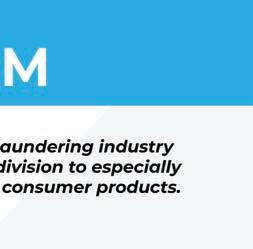



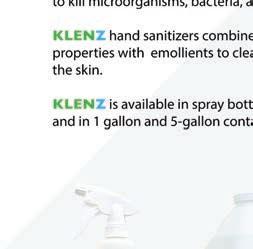
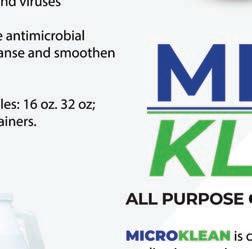
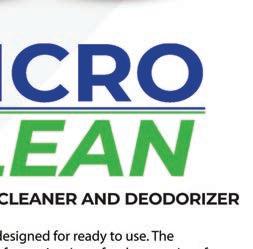



operations engineering in the Western United States/Western Canada for Cintas Corp.; Nick Fertig, director of central laundry at Rosen Hotels & Resorts in Orlando; and Bob Corfield, founder of the consulting firm Laundry Design Group.


How important do you consider it to set up laundry equipment as ergonomically as possible for the health of employees?
SAINT JEAN: Our staff’s safety and health is our top priority. We have many practices in place to reduce injuries and to keep our staff safe. This includes any equipment set up. The location, height, ease of use, all are important considerations.
COCANOUGHER: It’s extremely important that ergonomics be taken into consideration when designing any task, workstation or equipment. As we can design in maintenance and reliability benefits, we need also to design in ergo benefits, which not only impact safety and employee well-being, but can impact labor content as well.
FERTIG: An ergonomic facility is a critical component of a successful operation. Most, if not all, of the functions performed within a laundry are repetitive motion. Requiring associates to perform an uncomfortable motion over and over again is an easy way to ensure your facility will be riddled with workers’ compensation claims.
Ergonomic stations can help avoid the common sprains and strains we all experience.
CORFIELD: This is vital for both plant productivity and worker safety. We often perform HIAC (Hazard Identification, Assessment and Control) audits at workstations in a laundry to determine risk and performance. It would be irresponsible to not include this in modern plant design. Ergo-design and plant productivity are synonymous.
In an operation that is already working, what are some simple ways to alter layout or workflow to be easier on employees’ bodies?
SAINT JEAN: Avoid or limit over-the-shoulder movement. Lower corkscrew and final assembly bays. Install risers in all baskets. Conduct cross training/job rotation, and do daily stretching.
COCANOUGHER: Assess
material-handling practices. Trace the path of products through the plant—try to go linear vs. doubling back, crossing dirty with clean or crossing a path the product has already crossed in its journey through the plant.
A former colleague once said, “We don’t pay our employees by the mile,” so the same goes for the product. We need to limit travel of any product through the plant and minimize distance traveled, touches and handling. This can be modeled in many ways, but any way we do it requires a focused effort.
Finally assess the use of upgraded materialhandling tools—carts (add handles), casters (upgrade to better models), trolley systems (use trolley systems to move goods in larger quantities), etc.
FERTIG: Springloaded carts are an easy way to make a quick impact. Adjustable workstations so that associates can perform work at a proper height.
CORFIELD: Observation, measurement and interviews provide the basis for where the “low-hanging fruit” might be located in existing operations. Highly repetitive workstations and documented fatigue curves are high priorities.
What areas of a laundry are most difficult on employees’ bodies, and how can the processes be changed to ease it?
SAINT JEAN: In our laundry, our wash line is the most physically demanding position.
The loading and unloading process is easier if you use the proper unloading process, using the rotation feature, which allows the linen to fall out without using a lot of physical strength.
COCANOUGHER: Definitely loading and unloading trucks. For unloading, utilize the SafeLoad system that can be installed in Utilimaster-type step vans. This has a huge impact on unloading, helps control soil separation and speeds the unload process.
For loading, prebuild loads in appropriate carts with appropriate casters during the day so they can easily be loaded onto trucks at night.
Numerous cart systems now available include carts made to properly fit on trucks, lock into position for safety, and have adjustable shelves to accommodate varying loads and instill good ergonomic practices during the day’s journey.
FERTIG: The loading of washers is probably the most strenuous activity performed
within a facility. To help alleviate some of the stress, operations can consider overhead storage systems, cart dumpers and the height the washers are installed at.
CORFIELD: Sheets, blankets and mats are always high-value areas. Whenever possible, reduce or eliminate the problem at the source, reduce load size, use ideal work heights or make a substantial process change to reduce the impacts.
What products have you used that can help ease the impact of laundry operations on employees?
COCANOUGHER: Springbottom platform carts for garments. Add handles to any cart that rolls. Upgrade casters to make easier rolling of carts. Utilize trolley systems such as rail trolleys from Material Flow Systems to move product in bulk.
FERTIG: We have used items like trash grabbers to grab linen that has fallen on the floor to prevent constant bending. While not being a product, one of the easiest and most impactful activities is group stretching.
CORFIELD: In new plants we eliminate the problems first: ideal load sizes, auto conveyance of material to and from all possible workstations (elimination of as many floor carts as possible), automated transport (we call plant logistics) that uses gravity for load transfers, and more.
In existing plants, outside the obvious feeding folding machines, we look at ways to facilitate the exchange of floor carts and the presentation of processed work to the workstation.
Lifts for small-piece workstations, conveyors and automated wrapping or packaging systems. Automated bagging is a considerable game changer for most plants.
When laying out a new laundry, how can the operation be more ergonomically laid out for employee health and workflow?
SAINT JEAN: Install a tunnel washer—if poundage requirements are met—a rail system, an automatic final assembling unit, and wet cleaning equipment.
FERTIG: During the design of a new laundry, you have the opportunity to design what I like to call the “circle of life” in an operation.
From the moment the soiled linen enters the facility, the cleaning process should proceed in a circular motion, even -
tually ending up where it started to be loaded cleanly onto a truck. This helps prevent any double or triple handling, as well as any inefficient travel paths.
Are there any areas of a laundry or improvements that operators often overlook?
SAINT JEAN: Air conditioning.
COCANOUGHER: Don’t forget our maintenance and reliability teams! We often overlook working with our designers and equipment suppliers and wind up with a layout that makes life harder for these employees.
For instance, many manufacturers are finally redesigning their equipment to put all diagnostic tools (PLC, etc.) into a separate low-voltage cabinet, and keeping high voltage (>50VAC) in a separate cabinet.
Most often in diagnosing an issue, they only need access to the PLC, so now they can open it without exposure to what is officially “live electric,” thus they don’t have to dress up in all the NFPA70E PPE, work in the heat, battle the heavy-duty double set of gloves, etc. This is a huge improvement, but many manufacturers have been slow to convert their designs. Facility operators, the buyers, can force this conversion if only we will.
FERTIG: The separation or detangling of sheets is a big one. In the past, this type of equipment was faulty and frowned upon. Recent innovations have made this a staple in my facilities. The machines are efficient and have remarkable uptime. We are actually waiting for the delivery of a third unit.
Eliminating this task has been huge for us in regard to injuries and also morale. I mean, who wants to pull on knotted wet sheets for eight hours a day?
CORFIELD: Depending the type of plant, we see that soil sorting is often overlooked. Poor sorts or too many types of items have a direct impact on the clean packaging areas. But the biggest concern is plants that prevail on holding onto batch sizes that are too large to ergonomically handle. Usually this is due to machine capacity issues (dryer size of 350-600 pounds) that create loads that are too cumbersome for workers to effectively address and are often noted in workplace injury reports.
How has COVID-19 affected laundry setup for employee health and safety?
SAINT JEAN: Additional personal protective equipment (PPE), split staffing teams and split management teams. We now have temperature checks, masks are required and we do additional sanitizing.
COCANOUGHER: The “social distancing” creates the most impact. Not only does this impact the direct production areas, but it has also directly interfered with employees’ ability to socialize at lunch and breaks, thus impacting their enjoyment of being with their fellow workers at work.
Many companies are finding creative ways to stay in closer touch with their employees, developing additional activities that help build and maintain employee relationships, and fun activities to keep everyone engaged and having a good time at work.
FERTIG: Social distancing is next to impossible at some stations. As a result, we have built and installed partitions on multiple pieces of equipment.
CORFIELD: I think it is too early to fully tell, yet. Clearly where workers are in close proximity and where strenuous work prevails, PPE, air handlers, lifting devices will need to be employed.

What would your top ergonomic laundry advice be?
SAINT JEAN: Utilize job rotation to allow different muscles to be engaged.

COCANOUGHER: Start. Just start. First complete an assessment to determine which areas have the lowest-hanging fruit for your particular operation.
Develop a plan to implement your first project—engage your employees in the develop of a solution and play a part in the implementation. Get feedback after the implementation—whether it is handles on carts, new and different casters, spring bottom buggies, whatever.
Implement an exercise and warm-up system—this will also help battle the “social” impact of the social distancing now required.
FERTIG: Perform every job in your laundry for a full eight-hour shift. If the position was uncomfortable for you to perform, then you owe it to your team to identify a more efficient and ergonomic way to allow it to be performed.
CORFIELD: Have an owner, principle, manager or safety officer work every high-risk job for two to three days, “undercover boss” style. Then see what solutions make sense and start out with one at a time.
Don’t try fix the world all at once. Small steps work fine. ALN
6 JULY 2020 | AMERICAN LAUNDRY NEWS www.AmericanLaundryNews.com
Continued from Page 1
Setup
Saint
Jean
Cocanougher
Fertig
Corfield
KEEP THEM SAFE
THE RIGHT CLEAN MATTERS







Now more than ever, laundries must continue to ensure the health of their staff and customers through precise laundering. Whether you have an existing or new washer, Girbau Industrial has the adaptability to meet all recognized laundering standards. Available in capacities up to 255-pounds, Girbau Industrial washers deliver complete control over chemical dosing, water levels, number of baths & rinses, extract speeds and rotation action. All washers are ozone & UV disinfectant compatible and through auxiliary electric heat kits can be adapted to hit and hold up to 192˚F water without upgrading your hot water system.



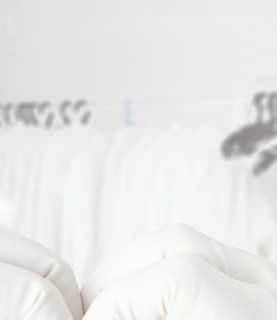

to support
Washers, Dryers, Tunnel & Ironing Systems | Equipment, Service & Support 800-256-1073 | girbauindustrial.com INNOVATIVE LAUNDRY SOLUTIONS INDUSTRIAL
In times like these, Girbau Industrial is here
you. Always has been and always will be.
0% Financing 90 Days No Payments * *Contact us for details.
Larry Trapani.
Wright is vice president of business development for Irving Weber Associates, which provides programs for the textile and linen care industries, based in Overland Park, Kansas. Trapani is president of Brooks-Waterburn Corp., a business insurance provider based in Farmingdale, New York.
INDUSTRY CHANGES IMPACT INSURANCE

One factor that has changed in the laundry and linen services industry is technology.
Trapani notes that there is a greater reliance on technology in the industry, and more laundries are investing in technology to improve the operations.
“As technology has emerged, the value of machinery has significantly increased,” adds Wright. “As consolidation occurs within the industry, plants are adding more routes to their operations, requiring more trucks, drivers, and hours driven.”
And operators need to be sure their insurance policies cover the level of their technology.
“It is important to note that most standard business owner policies have a special limit for computer equipment,” Trapani points out. “This is more than laptops. It includes servers, printers, cameras, as well as software. Take a look at your policy to be sure you have sufficient coverage for all your gadgets.”
Laundries even need to be aware of cyber liability in this day and age.
“What if somebody hacks into your payroll software and decides to give themselves a big bonus ” posits Trapani. “Cybercrimes are far more likely to happen to a small business that does not have the sophisticated security a larger firm has.”
Beyond computer technology, improvements in laundry equipment, chemistry and other materials have changed insurance needs.
“As improvements have been made in all areas, you can see the differences in a new plant floor plan versus an older plant,” says Wright. “Older plants run in tighter spaces with more risk; newer plants tend to have more space, run cleaner, and have fewer losses on the floor.
“Operators are now finding buildings that conform to their layout versus altering the flow of processing to fit an older, poorly designed building.”
In addition, he says that with a rise in litigation, his company is seeing more property owners and property managers require very specific insurance demands from operators entering the premises.
“Policy language for additional insureds and waivers of subrogation has become more common,” shares Wright. “Standards for hygienically clean goods will also continue to rise.”
IMPORTANT COVERAGES
When it comes to important insurance coverage in the industry, Wright says that fleet management and workers’ safety remain the highest areas of risk.
“These areas require a commitment from leadership with dedicated supervision toward ongoing best practices to keep workers safe and productive,” he says.
“Operations that make safety a high priority tend to run more smoothly and profitably.”
Trapani says that while there are hundreds of types of coverages in an insurance policy, regardless of the laundry type, the most important insurance needs can be divided into five main categories:
1. Business Personal Property: Business personal property is probably the most important coverage for an operation. Basically, it is protection for washers, dryers, water heaters, etc. He recommends
having coverage for “replacement cost.” An operation should have enough coverage so that if the entire operation is destroyed, there will be enough coverage to rebuild.
2. Business Interruption: If an incident, such as a fire, takes place and the business is closed for several months, this insurance pays for continuing expenses such as rent, loan payables and more.
3. Tenant Improvements: Tenant improvements covers items such as floors, walls,
electrical, plumbing, heating, etc.—improvements a business made at its expense.
4. Liability Coverage: Basically, this insurance covers an operation in the event it is sued for claims like “slip and fall.”
5. Workers’ Compensation: Most states require employers to carry workers’ compensation for their employees. It protects them in the event they are injured on the job. It pays for medical bills and lost wages for injured employees. Premiums are based on payroll—the higher the payroll, the higher the premiums.
COVERAGE EVALUATION
So, what does an operation need to do to evaluate its current insurance to find areas where it’s lacking, or where it’s over covered?
“The exercise of comparing exposure and risk with means of protection should be an ongoing dynamic that doesn’t get rushed into the final 30 days before insurance policies expire,” Wright shares.
“Try examining the insurance plans at the six-month mark of a 12-month policy so there’s no pressure to make decisions and there’s time to make capital investments.”
Trapani says the best way to evaluate insurance protection is to review coverages periodically with an insurance professional that specializes in the industry.
“They will know the right questions to ask and properly guide you to areas where you may have
The importance of automated uniform management systems
BY JONAS SCHREINER
LAVAL, Quebec — Since the beginning of the COVID-19 pandemic, many hospitals have been scrambling to ensure adequate supply and availability of scrubs for their doctors and nurses.
In her article “Top hospitals are facing a new supply shortage: scrubs,” Jessica Bartlett of the Boston Business Journal explains how the shortage has affected two large United States Hospitals: The Massachusetts General Hospital and Brigham and Women’s Hospital.
According to Bartlett, “the usage of scrubs had increased exponentially in the past several weeks, Massachusetts General Hospital and Brigham and Women’s Hospital officials wrote in memos circulated to employees. Coupled with supply chain issues, hospital officials say they will have to con-
serve scrubs supplies in the near term At the Brigham, use of hospital scrubs had risen 70% on weekdays and 300% on weekends.”
In the article, Charles Morris, associate chief medical officer at Brigham, and Julia Sinclair, Brigham’s senior vice president of clinical service, weigh in on the issue: “If providers do not have access to the scrubs they require, our ability to perform surgeries and care for patients in the ICU will be at risk.”
During these unprecedented times, it is crucial that hospitals have a system that allows them to track their scrub logistics to ensure clean scrubs are available to their employees at all times. The possibility of scrub shortages that inhibits physicians from providing timely care for their patients is a risk that can be easily prevented if a proper scrub management system is in place.
Over the past several years, many North American laundries have implemented radio-frequency identification (RFID) tracking systems to increase the efficiency of their processes and track their textiles with greater accuracy.
While these systems enable laundries to deliver precise usage and loss reports to their customers, they do not particularly help hospitals improve the transparency of their textile logistics on a daily basis. This remains a blind spot for many laundries, and most worrisome, for the hospitals themselves.
There are a number of vendors who produce RFID compatible dispensing systems. These dispensers are generally controlled through software that in many cases can be integrated with the various software platforms used by laundries.
Such solutions provide much needed inventory oversight for hospital linen managers, while
also providing greater visibility for laundries, allowing them to run a much leaner operation.
Also worth noting is that many of these smart dispensers are designed to help mitigate the spread of infection throughout the uniform distribution process. Several studies have shown that hospital uniforms can be transmission vehicles for the virus if the appropriate precautions are not taken.
According to Professor Ygal Bendavid and Professor Yasmina Maizi of the School of Management at the Universite du Quebec Montreal (UQAM), “The scrubsdistribution systems currently used at most hospitals do not prevent employees from manipulating the scrubs in the shelving areas, bringing them outside the hospital or hiding spare uniforms in their lockers—which would surely be non-compliant with infectioncontrol regulations.”
This is something that is often overlooked by linen managers, but, as Bendavid and Maizi note, it is important to consider “the hidden costs derived from scrubs contamination or shortages, the cost of losing a member of a medical team, and the cost of contaminating a patient.”
By using dispensers that limit unnecessary uniform handling and help ensure that contaminated workwear does not exit the healthcare facility, these risks can be greatly mitigated.
Nobody could have predicted that 2020 would unfold the way it has for the healthcare industry and the world at large, but those who made the decision to invest in uniform dispensers beforehand certainly saw their investments pay off. The Jewish General Hospital,
8 JULY 2020 | AMERICAN LAUNDRY NEWS www.AmericanLaundryNews.com
Coverage Continued from Page 1 See COVERAGE on Page 13
(Image licensed by Ingram Images)
See UNIFORM on Page 13
CLEAN, FRESH LINENS.


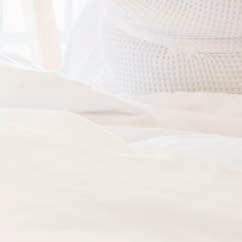




EVERY TIME.




As the world welcomes a new normal, plan now for how you’ll meet heightened guest expectations. Our promise to you? Next-level clean. TotalVue™ laundry technology leaves no doubt when it comes to cleaning your linens. You can easily manage heavy loads, lower operational costs, and emerge at peak e iciency in a post-COVID-19 world.











UniMac by Alliance Laundry Systems
for details.
Visit UniMac.com/Emerge
COVID-19 has changed the rules for laundry safety
BY BOB BRUCE
RIPON, Wis. — When you think of public safety, you usually think of police officers, firefighters and healthcare workers. After all, those workers keep you and others safe from things such as burglars and violence, fires and chemical spills, and disease and other traumatic injuries.
But in the aftermath of a pandemic caused by a novel strain of a coronavirus, you might want to add laundry workers to that list. It was just December 2019 when a new virus was detected in Wuhan, China. But since then, COVID-19 has spread rapidly, infecting more than 8 million people worldwide, including over 2 million in the United States, and killing 437,000-plus, including more than 118,000 in the United States alone.
OPL SAFETY IS NOT NEW
Long before anyone had ever heard of the coronavirus, onpremises laundry (OPL) safety had always been a priority. Keeping your laundry equipment clean and well maintained, and making sure your employees know how to correctly use the equipment, should always be a priority.
That includes properly loading the washing machine, confirming the right amount of chemicals are being automatically injected into the washer and ensuring that there are no chemical leaks. Don’t be afraid to rely on your chemical representative for help or to answer your questions and ensure that you are using the correct amount of chemicals in your specific equipment.
Environmental Protection Agency (EPA) guidelines note that although contaminated fabrics, particularly in healthcare facilities, can be a source of microorganisms, reports of diseases linked to contaminated fabrics are so few that the overall risk of disease transmission during the laundry process is negligible.
But the Centers for Disease Control and Prevention (CDC) suggest guidelines based on common sense and principles of hygiene. These include:
• Avoiding cross contamination by using color-coded carts designated for either clean or soiled linens.
• Minimizing the spread of bacteria during transport.
• Having hand-washing stations readily available.
• Wearing appropriate PPE when handling soiled fabrics.
• Minimizing contamination by partitioning your on-premises laundry room.
• Using hot water (temperature
of at least 160 F for a minimum of 25 minutes) while doing laundry to minimize bacteria and ensuring the correct tumbler heat temperature.
• Labeling chemicals and soaps to prevent injury.
ADDITIONAL STEPS IN A COVID-19 WORLD
With COVID-19, however, safety measures need to be expanded for your onsite laundry. Although there are no federal regulations in place, but rather recommendations, you need to be careful, consistent and thorough in your plan and operation.
According to the CDC, general contaminated clothing should not be shaken, but instead specially handled and laundered using the warmest possible wash temperature. It is generally advisable to use a standard laundering sanitizer additive in washing clothing. We also recommend a high temperature on the tumbler when possible and running a sanitize cycle in between wash loads.
One of the easiest and most important things you can do is to properly wipe down the handles and other contact points of washing machines and dryers that’s especially important if you have multiple people operating your equipment. Be sure you use EPArecommended disinfectants for cleaning to help reduce the risk of transmission and exposure, and always wear gloves appropriate for the chemicals being used for cleaning and disinfecting.
If you’re unsure if your disinfectant is recommended by the EPA, go to https://www.epa.gov/ pesticide-registration/list-n-disinfectants-use-against-sars-cov-2
In addition, make sure your employees have access to soap and water, or alcohol-based hand sanitizer (at least 60% alcohol), and that they wash their hands frequently.
Practice social distancing and leave 6 feet between employees. That may be easier in a limited service hotel that has only one full-time employee (FTE) doing the laundry. But in select service or luxury hotels, that will likely be more difficult, particularly as hospitality rates start to increase and people become more comfortable with traveling again, causing the need for more laundry to be done.
Moving forward, I would assume that many hospitality chains will start testing employees for COVID-19, if they do not do so already.
While there is still much to learn about the novel coronavirus, the CDC says the virus is most often spread from person to person. The CDC knows that transmission occurs via respiratory droplets, but it is still unknown how long the air inside a room occupied by someone with confirmed COVID-19 remains potentially infectious.
So if someone in your OPL facility is ill or suspected to be ill with COVID-19, it’s important that you take measures to improve ventilation in that space, and thus help shorten the time it takes for the droplets to be removed from the air.
The CDC also recommends employees wear face masks. You may also want to check with your local or state health department for their specific and up-to-date recommendations as conditions change rapidly and differ from state to state.
THE IMPORTANCE OF TECHNOLOGY
However, I believe it will become increasingly important for OPLs to prove that everything is being laundered properly. Thankfully, today’s equipment makes it easy to determine that.
Technology-based machines can give you data such as what your pH level is on each and every load, allowing you to prove that the finished laundered items are sanitary. I see that as a next step that hospitality partners will employ to ensure their loyal customers have peace of mind while staying at their properties.
For those working in onsite laundries in nursing homes and assisted living facilities, where many cases of the coronavirus have been diagnosed, attention to detail and cleanliness is more important than ever. In fact, the impact of COVID-19 on those facilities has been drastic.
That’s because people inside those facilities are most at risk for complications and death due to the coronavirus. Nationwide, 33% of coronavirus deaths, or at least 28,100, are nursing home residents and workers, The New York Times reported, adding that the virus had infected more than 153,000
at some 7,700 facilities by midMay. Other news reports show even higher percentages, such as 40 to 80%, depending on region, according to data compiled by The Foundation for Research on Equal Opportunity.
While there are no mandates in place for proper laundry procedures in healthcare facilities due to COVID-19, it’s clear that you must take huge steps to make sure that everything is clean and sanitized.
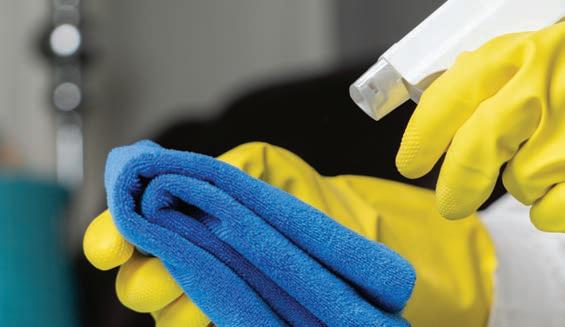
Most nursing homes are on lockdown and allow only staff to come in, so it’s important that your machines are properly maintained and operating correctly with the proper amount of chemicals, that your employees are being tested, and that you are taking safety procedures to keep them—and the residents—safe.
To learn more about the CDC’s rules for cleaning and disinfecting community facilities, go to https:// www.cdc.gov/coronavirus/2019ncov/community/organizations/ cleaning-disinfection.html ALN
Bob Bruce is director of national accounts sales at Alliance Laundry Systems. Bruce has eight years of laundry industry experience, spanning both coin laundry and on-premises laundry markets. He can be reached at bob.bruce alliancels.

10 JULY 2020 | AMERICAN LAUNDRY NEWS www.AmericanLaundryNews.com
(Image licensed by Ingram Image)
OPL safety has long been a priority, but now it’s more important than ever for employees, author says
Bob Bruce
How will COVID-19 impact construction pricing?

 BY ED KWASNICK
BY ED KWASNICK
CHICAGO — As COVID-19 continues to impact the world’s economy, one of the main questions inside the construction industry is, “What will happen to pricing ” Can we expect to see a major reduction in pricing, will it hold steady or potentially increase Before addressing this, let’s start by defining the main factors that impact construction pricing.
Supply & Demand: Construction pricing is highly sensitive to the forces of supply and demand. Cutting pricing is inherently risky and can equate to a lot of work for little or no reward. Thus, when demand is high, construction pricing increases to reduce this risk.
When demand decreases, however, contractors are willing to pursue riskier projects at reduced pricing to keep their businesses moving forward.
Backlog: Backlog is the amount of construction work currently on the books. When the economy is strong, backlog and pricing increase, creating a buffer. This buffer causes a lag in how quickly construction is impacted by, and reacts to, current economic conditions.

Labor Costs: Construction is labor intensive. It is difficult to run wire, hang pipe or lay block without skilled labor. Because of this, a large portion of construction costs are determined by labor expenses.
Wages increase as the cost of living goes up and construction costs follow. This explains why the cost of construction is higher in New York City, Northern California and other regions with a higher cost of living.
Commodity Pricing: Commodity pricing plays a role in determining construction costs as well. When oil prices go down, so do petroleum-based products, such as insulation, asphalt and roofing materials. When steel prices increase due to new tariffs, the cost of joists, metal panels and pipe increases accordingly.
No single factor drives construction pricing. Numerous economic forces have varying degrees of influence, and this makes predictions about pricing somewhat challenging.
We currently know that demand for new construction is decreasing due to a contracting economy.
Contractor backlog is beginning to shrink, and commodity prices are low. These three indicators point to an impending reduction in construction pricing.
Because the construction industry typically lags the economy, an economic inflection does not equate to an immediate reaction.
Instead, prices hold steady while the industry works through its backlog and assesses the economic
situation. Then, as backlog levels begin to deplete, contractors are willing to take more risk and lower their pricing to secure additional work.
Once the forces of supply and demand, backlog, labor costs, and commodity pricing reach a new equilibrium, construction pricing will level off, maintaining this new baseline until demand begins to increase once again.
So, what will happen to construction pricing Currently, it has leveled off and will stay flat as contractors continue to work through their backlog. Then we expect pricing to become more aggressive as backlog begins to shrink.
However, these are unprecedented times. Predicting when and how prices might decline is, at best, a guessing game that does not necessarily lead to a fruitful
construction experience.
Ultimately, success is determined by working with a proven construction partner that can lower your risk and improve your return by:
• Clearly defining the scope of work.
• Locking in firm pricing early in the process.
• Developing creative solutions.

• Minimizing project delays.
•

Bacteria
Pathogens
The Braun Medicare Top Side Loader Washer/Extractor
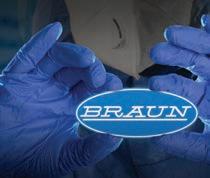
Braun Medicare TSL Washer/Extractors are specifically designed for laundries requiring a highly-efficient, hygienic processing environment.
If your application requires a contamination-free, clean room environment, the Braun Medicare TSL is a perfect fit. In the contamination-free environment, soiled laundry loads from one side; clean laundry unloads from the other. In a clean room facility, a full wall barrier and our patented Mediflow negative air-flow system prevent cross contamination of goods during the process.
Braun Medicare TSL Washer/Extractors are available with dry load capacities of 200, 400, 600 and 800 pounds. Unlike others this machine can be sling loaded and features an automated door.
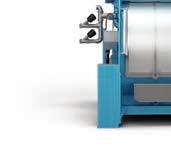

Learn more and see it in action visit gabraun.com Made in the USA | ISO 9001 Certified

The leading ergonomic split-pocket design since 1965!


 Delivering as promised. ALN
Delivering as promised. ALN
www.AmericanLaundryNews.com AMERICAN LAUNDRY NEWS | JULY 2020 11
Ed Kwasnick is director of business development for national construction company ARCO/ Murray.
Harmful
and
have met their match.
ALN_Jr Page.indd 1 5/28/20 1:09 PM
Ed Kwasnick
PANEL OF EXPERTS
Permanent laundry changes due to COVID-19
in necessary until that happy time we have a vaccine or cure. We are all looking forward to a beer at the ballpark or bar then, and a better haircut.
As it became apparent in early March that our country and our world were facing an unprecedented health crisis, we, like other companies, had to urgently think of the health of our workers and how to keep them as safe as possible.
Thankfully, like most manufacturers in the United States, our employees generally already worked at a social distance from each other, but we decided to sit down with both plant managers to figure out how to further enhance our protocols.
First, thankfully we have four manual sewing stations and talented seamstresses who were able to craft masks for all of our employees from our own sheeting fabric, which is incidentally one of the best fabrics for both ventilation and breathability.
Secondly, we staggered times for punching in at our timeclock, for our lunch and breakrooms, so everyone could be socially distant even when not at their work areas.
Third, we made sure the common areas were cleaned regularly and all employees cleaned their own work areas before any other employee used the same equipment.
Fourth, we identified our highest risk employees and found out ways they could provide input and value while working from home.
Finally, we created paperwork routines for our office and dock so that contact between our employees and freight carriers was limited.
The outbreaks in meat packing plants all across the country show that crowded indoor spaces can lead to tragic outcomes for workers and their communities. The area near our office was an early outbreak area, and I personally know victims who haven’t survived and other seemingly healthy victims in their early 50s who barely survived.
As we move forward and lockdowns ease, continued vigilance

“Improvise, Adapt and Overcome” is a slogan the United States Marine Corps uses as a philosophy. COVID-19 has required laundries and business of all kinds to also adapt this philosophy.
Healthcare laundries have always strived to protect our employees from contaminated soil linen by putting them in personal protective equipment (PPE). The use of gowns, gloves, mask and eye protection is our normal operating procedure.
On our “clean side” of the plants, we have strived to protect the linen from our employees— we clean our conveyor belts and floors; we maintain proper air flow to ensure we are not allowing contaminated air from our soil area. We package the clean linen in plastic or at least cover the transport carts to ensure the linen will be “hygienically clean” when it arrives at our customer base.
COVID-19 has now made us look at another critical area of our job. How do we protect our employees from each other? I know in cold and flu season we experience high call-ins for sick days due to employees having the flu. But I never really thought about them getting it from each other.
COVID-19 has brought attention to the fact this may very well be a real possibility. Measures we put in place now may pay huge benefits going forward in keeping our employees healthy.
Here are some the changes we have made to help protect our employees from each other that I feel will pay dividends going forward:
1. Increased cleaning of the break room and spacing employees out while on break.
2. Employees working within 6 feet of each other must be wearing a mask or have some type of protective barrier.

3. Wiping down machinery with sanitizing wipes at every break or when employees rotate to different machines.
4. Hand sanitizer at every workstation. Employees will clean their hands more when it is easily available to them.
5. Temperature checks of all employees when their shift begins. This small change has made employees more comfortable working around each other.
6. Having hand sanitizer and mask available for all visitors to our plant.
lenging and reducing contact in the building by directing foot traffic to specific directions when possible.
Masks and individual hand sanitizers have been provided to employees to eliminate any obstacles for individuals to follow public health guidance that will aid in protecting themselves and others from illness.

The COVID-19 situation continues to develop and evolve. Ecolab closely follows updates and adheres to guidance from the World Health Organization (WHO) and the Centers for Disease Control and Prevention (CDC).
While it is unknown how long the COVID-19 risk will continue, having a greater awareness of the health and safety of our workplaces protects employees and minimizes disruptions in business operations that any communicable illness can impose.
know that lapses have occurred. With time, people naturally become comfortable in their work environments; comfort leads to complacency, and complacency leads to diminished adherence to safety rules, including hygienic practices.
Pre-COVID audits of every size and type of laundry bear this out, with consultants taking pages of audit reports to remind management of their own safety rules and those of local, state, and national governments.
As laundries around the world re-open, team members have a greater respect for these rules and compliance is near 100%. We hope it stays that way.
Beyond the pre-COVID rules for personal protective equipment, considerations for bloodborne pathogens and the like, the “new normal” for the foreseeable future requires operators throughout the industry to find new, innovative and important ways to keep their team members and their customers safe and healthy, starting with the arrival of employees to work each day.
Ecolab has always placed a heavy emphasis on safety and cleanliness in their facilities to ensure a healthy work environment for employees. However, in the wake of COVID-19, all practices and protocols were evaluated, and adjustments were made to activities that previously were viewed as low risk to employee safety.
The immediate response to COVID-19 in manufacturing and R&D facilities was to promote social distancing and further increase cleaning frequency and thoroughness. Starting at the door, there are reminders for employees to conduct a health self-evaluation. The first defense in keeping employees safe and prevent the spread of illness is to avoid introduction into the building in the first place.
Hand sanitizers are even more prevalent throughout the building, in addition to updated and increased cleaning protocols of communal spaces.
Social distancing is being administered by designating shifts where they previously did not exist or reducing the number of individuals per shift, requiring employees to sign up to use a space in which social distancing would be chal-


First and foremost, I hope that you, your families, your colleagues and team members, and their families are, and have been, safe and healthy throughout the past few months as we have endured this pandemic separately but together.
The phrase, “we’re all in this together,” has been repeated so many times over the past few months that it sounds cliché, although I think truer words have never been spoken.
That is why, as we work to reopen our local, state, and national economies, it is so important that we take care to ensure the safety, health, and well-being of our team members, customers, and the communities we serve. As with all things, this begins at home which, in this case, means our laundries.
Industry publications, trade associations, safety experts, consultants, insurance companies, governmental agencies, certifying bodies and your own team members have for years made the safety of personnel a value and a priority, but if we are being honest with ourselves, we
Interim guidance from the CDC for critical infrastructure operations like laundries is to do all that is possible to ensure that only uninfected workers come to work each day. This means that only those who are asymptomatic and have not had a positive test result for COVID-19 can begin work.
In many cases, laundry operators are checking the temperatures of employees before they begin their workdays; however, it must be stressed that those who are infected but asymptomatic may not have an elevated temperature. With this in mind, additional precautions are being implemented in laundries to protect all workers and their customers.
Laundries have always been places where employees are supplied with and trained in the proper use of personal protective equipment (PPE) and hand hygiene, but whereas PPE for hygiene was primarily employed in the soiled areas of the laundry, we are now seeing the use of face masks, face shields, barrier garments, gloves and other PPE expanded throughout entire facilities.
There is also an increased and enhanced focus on hand hygiene throughout laundry facilities.
“As we start to work in the ‘new normal’ of COVID-19, what are some best practices being permanently installed by operations for safety and cleanliness?”
Consulting Services
David Bernstein Propeller Solutions Group, Park City, Utah
Textiles
Timothy Voit Thomaston Mills, Wyncote, Pa.
Commercial Laundry
David Griggs Superior Linen Service, Muskogee, Okla.
12 JULY 2020 | AMERICAN LAUNDRY NEWS www.AmericanLaundryNews.com
Chemicals Supply Lauren Hunker Ecolab, Eagan, Minn.
Additional handwashing and sanitizing stations are being added throughout plants, with an increased emphasis on touch-free sanitizer and soap dispensers as well as faucets, toilets, light switches and even areas where employees clock in and out for their work shifts.
Once workers enter the facility, social distancing must be maintained. According to the CDC’s web site, “current information about the asymptomatic spread of SARSCoV-2 supports the need for social distancing and other protective measures within a work environment.”
In other words, areas throughout a laundry and the production methods employed are being changed as much as possible to ensure the maintenance of appropriate distancing between workers.
We are seeing this throughout laundries including, but not limited to, soil reception, soil sorting, the washroom, finishing and folding areas, storage, and pack-out. A variety of means of reminding workers of these distancing requirements are being implemented, not the least of which is the use of signs and floor markings.
In areas where distancing is difficult, we have seen a number
of innovative ways of trying to decrease or eliminate the possibility of the asymptomatic spread of COVID-19. This includes the use of plexiglass, strip curtains and other physical barriers between workers, as well as requirements for workers to wear masks over their nose and mouth and/or face shields.
In some cases, this also means that personal cooling fans are being removed and ventilation systems being modified to minimize the risk of virus spread.
In addition to the modification of work areas, emphasis must also be placed on ensuring that break rooms and cafeterias do not become vectors for the spread of the virus.
One way to keep this from happening is to stagger break times, but it may also be necessary to remove some tables and chairs from a break room to ensure proper distancing or to provide temporary break rooms in other areas (e.g. conference rooms, training rooms, etc.) or by using temporary tents, outside tables and chairs, or other measures.
Just like in work areas, the use of signs and visual indicators will help remind workers to be vigilant, even during break times.
There are likely myriad other
ways that laundry operators are trying to ensure the safety of their employees and their families, but the previous are some of the measures that seem most prevalent, and perhaps permanent, as we continue to navigate our way through these uncharted pandemic-infested waters.
Stay safe and healthy, my friends.
ing and also the number of seats at each table. This also meant that we would need to stagger who took breaks and when so that only enough for the number of tables and seats would be on break at a given time.
The cleaning of the area with specific cleaning materials and the amount of times for high-touch areas in the breakroom were increased.
distancing. We moved the towelfolding machines so that there was at least 6 feet of spacing between the machines.
Laundry
This has certainly been something we have never seen before during our lifetime, as it would have been hard to imagine hotels, restaurants, theme parks and businesses closing for extended times.
As we begin to recover, our operation has looked closely at how we can safely operate and keep our employees at a low risk when we resume the business of processing laundry.
We changed our breakroom, moving tables to maintain a 6-foot clearance for social distanc-
All visitors must enter through our front entrance and are required to wear a mask during their visit. Only visitors with a valid reason would be allowed to enter the laundry processing area. Each visitor is given our guidelines that need to be followed during their visit.
We placed signs in different languages throughout our facility reminding our employees about social distancing and washing hands and our management team was trained on how to properly coach someone if they were not following the proper guidelines. At this particular time this includes all employees wearing masks until at least phase three of the recovery plan is in place.
There were several concerns that we needed to address in the processing area such as social
Coverage
Continued from Page 8
too little or too much coverage,” he says. “It is important to be truthful when you review your coverage.
“I have found recently that insurance companies are denying claims if an insured misrepresents information. You may pay more for insurance, but at least you will have coverage that you can count on.”
Wright says that many laundry operators haven’t spent enough time planning for disaster recovery, which includes insurance coverage.
“Is there a communication plan with staff? With customers? How will processing be moved or outsourced? Have insurance policy coverages been assessed to provide an immediate means for recovery and cash flow ” he asks.
In addition, Wright finds that the replacement cost of equipment, contents, is often undervalued.
“It’s important to use data such as a balance sheet to keep the limits reflective of the values,” he shares.
Ideally, Trapani says a laundry should have a standard business owner insurance policy with a top-rated company.
“Have coverage that would make the customer whole after a loss,” he says. “In other words, carry high enough limits that they
are fully protected. Also, have a workers’ compensation policy with payroll of all employees.”


Wright adds that any insurance plan should be continually updated in terms of value for buildings and equipment. Also, it should be a plan that

incorporates safety and training as common culture. Prevention is always better than regret.
“Work with an insurance professional who knows the industry and is willing to share best practices and experience,” he concludes.
ALN
Uniform
Continued from Page 8
Montreal’s designated COVID treatment center, is one of those hospitals, and their head of laundry services, David Diachidos, was kind enough to share his experience with this equipment.
Diachidos’s initial concerns were similar to those of the two Massachusetts hospitals mentioned earlier: “Since the pandemic hit North America, hospital uniforms became a very hot commodity. The demand for scrubs went up very acutely overnight, and there was no supply in the market to back it up we had to do more with less.”
He commended the hospital’s uniform distribution and management system as the indispensable tool that helped them cope with the situation.
“Fortunately, we had a uniform distribution system from ABG Systems on-site ABG’s system allows us to operate in an extremely lean fashion,” shares Diachidos.
“Rather than sending uniforms to many different locations and having to overstock these units, only the uniforms that are needed are used. The machines also control the inventory by blocking users from taking more uniforms until they have returned their previous sets, and of course, ensure 24-hour availability of all sizes for all employees.
“The system also helps us ensure a higher level of hygiene during the
We added plastic spacers between the pillowcase machine feeding stations as a layer of protection between the employees. We added the same type of plastic spacers along the sorting line as well. The spacers are removable so you can adjust based on the number of employees working in the area.
More hand sanitizers were added throughout the building so that easy access to sanitizing was available, including all bathrooms and exit areas. All hand sanitizers were checked as part of the increased cleaning process to make sure they were always filled and working.
Finally, our electronic information board provides daily safety practices with a heavy emphasis on COVID-19 information, such as what to do if you begin to feel ill during the day.
I am sure there are many more changes and improvements to come as we continue to cross uncharted waters, but to all I end with hoping all of you are staying safe through these trying times for our industry. ALN
uniform distribution process by limiting uniform handling to the end users. The uniform distribution system has helped us weather this storm and ensure exceptional service to the brave health care workers on the front line.”
Hospitals that use RFID dispensing systems are able to cut costs in three main areas. Studies have shown that uniform loss will decrease by up to 90%, resulting in lower uniform replenishment costs.
The increased control translates into lower levels of uniform usage, which reduces laundering costs. Lastly, full inventory transparency eliminates the need for excess safety stock, allowing for a reduction in overall stock levels.
Pandemic or no pandemic, when coupled with the numerous soft benefits of these systems (inventory mix optimization, usage reporting, restock notifications, user accountability, etc.), automated dispensing will not only drive cost savings, but increase efficiencies as well. ALN
Jonas Schreiner is business development manager for ABG Systems North America, based in Laval, Quebec. He has a strong background in finance and economics and is well versed in RFID implementations for the healthcare and commercial laundry industries.
www.AmericanLaundryNews.com AMERICAN LAUNDRY NEWS | JULY 2020 13
Hotel/Motel/ Resort
Phil Jones Hotelier Linen Service, Lakeland, Fla.
Schreiner
(Image licensed by Ingram Images)
PRODUCT SHOWCASE
Tunnel Washers
GIRBAU INDUSTRIAL
Girbau Industrial says its TBS50 Continuous Batch Washer is highly configurable to meet the labor, efficiency, quality and productivity needs of virtually any medium- to high-production laundry operation.
Available in five to 12 modules, each with 110 pounds of capacity, the TBS-50 processes from 1,000 to 3,000 laundry pounds per hour. Girbau Industrial says that thanks to its smart, dual-drum modular design, the TBS-50 is less costly and simpler to install than comparable machines on the market, uses less water and energy, runs quietly, and delivers a quality wash for any fabric type.
washer, without the limitations imposed by transfer scoops or an Archimedean design.
Braun adds that its monoshell, stainless-steel design provides perpetual cleaning of the cylinder, affording an environment for the effective and hygienic processing of linens. The non-porous, stainless-steel tub, tanks, and process piping minimize the growth of biofilms. Also, there are no stagnant bath or outer drum surfaces, which can become incubation chambers for microbial growth.
(IoT) and robots to match machines to site requirements, assuring the perfect utilization of resources. The systems deeply integrate big data and artificial intelligence to comply with the unprecedented trend of industrial evolution and innovation.
www.sealionamerica.com 860-316-5563
PELLERIN MILNOR CORP.
Milnor says its PulseFlow Technology has been successfully employed in the laundry industry since 2009. With low freshwater usage and utility savings, PulseFlow technology offers lower operating costs and higher production rates.
Each module is individually programmable for water temperature and levels, duration of the wash cycle, mechanical action, bath partitions, rapid draining, chemical injection and closing parameters, among others.
Offering detailed management over the wash process, the TBS-50 control allows users to manage more than 999 client accounts and offers 99 washing programs. Real-time data regarding the wash process is viewable from the main screen, and from easily accessed sub-screens.
www.girbauindustrial.com 800-256-1073
G.A. BRAUN
G.A. Braun says its SmoothFlow Batch Tunnel Washing Systems offer “new technology, backed by science.”


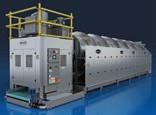


The systems utilize Braun’s Tunnel Infusion Technology . This trademarked technology for delivering aqueous chemistry to each processing zone optimizes agitation and mixing. When combined with Braun’s unique “Open Helicoid” cylinder design, the company says it affords mechanical action consistent with that of an open pocket
Braun tunnels are available in processing classifications of 100-150 pounds and 200-220 pounds.

www.gabraun.com 800-432-7286
SEA-LION AMERICA COMPANY
Sea-lion America Company says its SDX tunnel washer systems are available in 130-pound and 175-pound batches up to 16 modules. The systems feature excellent mechanical wash action and reliable bottom transfer processing.
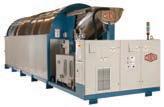
Low water consumption is achieved via a built-in water reuse system, and a wide variety of goods can be processed thanks to the combination of single-drum and double-drum technology.
The company says its SCADA control platform provides for full wash system programming and complete system monitoring.
Sea-lion says its automated systems make good use of the Internet, the Internet of Things
For light soil linen, the company says water consumption is as low as 0.3 gallons per pound, and for most heavy soil linen, the expected water consumption is as low as 0.5 gallons per pound.
PBW washers (110-, 150- and 260-pound capacities) feature True Top Transfer with perforated transfer scoops that lift the goods out of the water, drain the free water, and then slide the goods into the next compartment, thus introducing them to cleaner water.
Additional features include large cylinders that provide significant space for superior dilution and excellent mechanical action that accelerates dilution.
PulseFlow tunnels are paired with either a single-stage press or centrifugal extractor, making them flexible for all types of commercial laundries.
www.milnor.com 504-467-9591

JENSEN USA
With more than 3,200 in tunnels in operation, JENSEN says it offers unique concepts such as the Universal tun-
nel washers with FlexWash and FlexRinse Technology, which features total batch integrity; the patented Universal Mediline, which features no enclosed process tanks on the tunnel and the “TopDrain” style extraction press with no external tanks for maximum hygiene level.
In addition, JENSEN offers options such as QuickSoak and UVClean. With QuickSoak, the company says goods that tend to “float” on top of the water (such as barrier gowns or Gore-Tex items) are forced underwater due to the very efficient, precise and faster soaking in the first compartment, higher mechanical action, faster soil removal and an improved distribution of chemicals. No extra maintenance or utilities are required.

As technology allows for lower water consumptions, a result can be a biofilm buildup in the last compartment, and possibly between the tunnel and the press. JENSEN says UVClean can be installed in double drum sections to prevent bacterial growth and without any chemical supply. Also, bacteria cannot become resistant to UV radiation. And finally, the process tracks the tempera-
ture and time for each batch to ensure proper disinfection.
www.jensenusa.com 850-271-5959
LAVATEC LAUNDRY TECHNOLOGY
Lavatec Laundry Technology’s newest tunnel washer is the LT130, with batch capacity of 286 pounds. The company says that like its other machines, it offers a low operating cost for the industry.
The LT130 manages up to 114 wash programs with touch-screen controls, is freely programmable and comes with a fault diagnosis system to maximize uptime, says Lavatec. Maintenance is made easy with four motor-powered drives for chamber rotation that never need lubrication and does not use chains or sprockets.
The LT130 can handle all temperatures and disinfection processes, with counterflow or standing bath waterflow designs


that offer the most flexible wash parameters for all laundry needs, according to Lavatec. The company says it specifically designs each tunnel to meet customers’ needs, with the ability to fill and drain and provide chemical injection and steam in every compartment if requested.
www.lltusa.com 203-632-8777
VEGA SYSTEMS USA
Available in a large variety of sizes, VEGA Systems says its SmartLine Tunnel Washer is an industrial tunnel washer built to uphold high
14 JULY 2020 | AMERICAN LAUNDRY NEWS www.AmericanLaundryNews.com
COMPILED BY MATT POE, EDITOR
See TUNNELS on Page 16
Girbau Industrial
G.A. Braun
Pellerin Milnor Corp.
Sea-lion America Company
JENSEN USA
Lavatec Laundry Technology
VEGA Systems USA
RICHMOND, Ky. — Because of the postponement of its 2020 IMPACT Conference due to the coronavirus/COVID-19 pandemic, the Association for Linen Management (ALM) held its annual member business meeting virtually for the first time in history May 14.
During the meeting, ALM announced the next generation of board leadership to continue the association’s efforts of providing essential education and resources for the industry, along with sharing bylaw amendments.
In addition, the association provided educational and program updates.
BOARD OF DIRECTORS, BYLAWS

Prior to the virtual meeting, ALM members voted for the next president-elect, secretary and treasurer to the ALM board of directors, as well as amendments to the association’s bylaws.
James Mangini, RLLD, is the new president-elect. Mangini has 15-plus years of experience in the industry as the director of linen services for Maine’s largest medical center, Maine Medical Center Linen Services.
“I am thrilled to have the opportunity to serve as the president-elect of ALM,” says Mangini.
“Our educational platform is second-to-none and has had a tremendous impact on my professional growth. I look forward to working with our great membership as we continue to promote the reusable textile industry.”
Nicole Grubich, RLLD, CLLM,


will be the new secretary. Grubich has been an ALM member for 18 years and is a leader in the industry, as well as within her region of Grand Rapids, Michigan. She is the executive director of West Michigan Shared Hospital Laundry.
“As a member of ALM for almost 20 years, I am elated to serve the association as board secretary,” says Grubich. “I look forward to continuing the amazing work ALM has done over the years. I’m so grateful for this opportunity. Thank you ”
Jason Hartsell was re-elected as ALM board treasurer and will continue his work in guiding the association’s financial planning. Hartsell is the director of operations for United Hospital Services in Indianapolis and a veteran who was awarded the Bronze Star Medal and Combat Action Badge for his deployment to Afghanistan.
“I’m honored to be elected to serve as ALM’s treasurer for an additional term and continuing to be a part of such an outstanding organization,” says Hartsell. “ALM continues to be a leader in providing information and training to laundry and linen operations across multiple markets.
“It’s been a privilege to be a part of so many new and exciting programs released recently, including benchmarking, new certificate and training programs, and an entire eLearning suite. All the while, ALM continues to serve as a resource the textile industry relies upon for information.”
Besides the elections, ALM
members voted to remove the Practice Guidance Council from standing committees, due to the move from an ALM committee to the separate organization, the Textile Research Council.
They also voted to add the Leadership & Advisory Council, which will create a diverse body of industry leaders attuned to changes in the industry across all service segments and provide an incubator for the development of volunteer ALM leaders.
Cindy Molko, RLLD, CLLM, and Shane Woodson, CLLM, are exiting from the board as past-president and secretary, respectively. ALM is pleased to announce that they will both be remaining within the ALM family through their work as subject matter experts for various ALM projects and programs.
“Cindy has been a tremendous value to ALM and to the industry at large. She brings a lot of talent to us and we’re so glad to keep her on in other capacities, including on the Textile Research Council. Much thanks to her,” says ALM Board President Judy Reino.
“Shane has performed an amazing job keeping our records as we have gone through some changes, all for the better, and he has helped usher us through those changes and maintained needed documentation. We will miss them both from the board but are happy they will still be working with us regularly.”
PROGRAMS, EDUCATIONAL UPDATE
Executive Director Linda
Fairbanks also gave updates during the virtual meeting about the many programs and educational opportunities offered by ALM.
As mentioned earlier, the 2020 IMPACT Conference has been rescheduled for November 2-5, and will still be held at The Broadmoor in Colorado Springs, Colorado. Additionally, both Laundry & Linen College tracks, Textile Care Services and Laundry Processing and Operations, will be held concurrently September 21-25, 2020, in Richmond, Kentucky.

Fairbanks made two important announcements that will impact all professionals in the industry. The first, that beginning in June 2020, the number of required questions for the LaundryMarks benchmarking platform will decrease, thereby increasing how many participating laundries are able to pull full reports.
“We are, like most programs, evolving,” says Fairbanks. “When you first start on anything, you want everything, but after learning the extent of your constraints, you realize you have to scale it back.
We are in the process of decreasing the data demanded in LaundryMarks. Laundries may still enter all the data points however, by making fewer points required, many of the laundries will be able to move ahead with reports and comparisons.”



Currently, 93 laundries are registered within LaundryMarks, and fiscal year 2019 data entry opportunity will be available soon.
Fairbanks then moved on to
talk about ALM’s TRAIN eLearning System, which offers selfpaced, interactive instruction to engage learners. ALM announced its Certified Laundry and Linen Manager (CLLM) certification available through TRAIN during the 2019 Clean Show.
During this virtual meeting, there was another certification announced: Mastery of Healthcare Linen Management (MHLM).


“At last, linen managers will have credentials to highlight the value they bring to their organization,” says Christina Horsley, ALM director of events & education. “Those who enroll in this new certification will learn about healthcare linen management practices, linen utilization, cost management and so much more.”
Fairbanks says the first course of the Linen Mastery certification, Evaluate and Select Hospital Textiles, is available now, with the full certification available later this year.
She concluded her presentation with an ALM fiscal update. The association remains strong, working with the hospitality industry to restore trust for travelers, and with the reusable textile industry to ensure the continued availability of needed linens and (personal protective equipment) PPE.
ALM event revenues and investments are down due to COVID-19, but the agility within ALM has made it possible to adjust events, including contingency plans to make those events virtual if a fall surge demands further travel restrictions. ALN
www.AmericanLaundryNews.com AMERICAN LAUNDRY NEWS | JULY 2020 15
ALM hosts annual member business meeting virtually ANTIMICROBIALCARTS FOR EVERY APPLICATION POLYVINYLWIRE R&B Wire Products is the first manufacturer to offer a complete line of antimicrobial carts and trucks. Protect your facility and customers. Poly, vinyl and powder coated materials feature antimicrobial additives designed to combat microorganism growth. www.rbwire.com 1-800-634-0555 ALN_3rd Page.indd 1 2/28/20 8:15 AM facebook/americanlaundrynews @AmericanLaundryNews LIKE our Facebook Page SHARE our Content FOLLOW us on Twitter COMMENT: What’s on your mind?
BLOOMINGTON, Ill. —
Hermes Commercial Laundry Equipment, a laundry equipment distributor located here, reports that in March it named Robert Mattocks its vice president of sales.
He will report directly to company owner Mark Wilkins.
Hermes says Mattocks brings more than 15 years of account management and sales experience to his new post.

Most recently, he was the national channel sales manager for laundry payment systems maker Card Concepts Inc. (CCI).
Mattocks says he couldn’t be more excited to continue his laundry industry career with the Hermes team.
“Continuing the rapid growth of Hermes will be a big challenge, and I feel we have all the pieces in place to take our initiatives to the next level,” he says.
Hermes distributes equipment for Speed Queen, Yamamoto, Sankosha, B&C Technologies and several other lines.
Knox joins Meese as regional sales mgr., Western U.S./Canada
MADISON, Ind. — Meese Inc., a designer and developer of plastic rotomolded products, has named Steve Knox as its regional sales manager for the Western U.S. and Canada.
Meese says Knox joins a dedicated team of sales profes-


Track Career
sionals offering the company’s Poly-Trux line of ergonomically designed, antimicrobial rotomolded solutions for linen transport, materials handling and storage.
During Knox’s career in sales and sales management in the Western U.S., he was able to bring new ideas to help target new markets and expand OEMs and distributors’ core businesses. His broad direct manufacturing and product experience ranges from electronics to elastomers (rubber) to ergonomics and specialty metal.
“We are excited to have Steve on the Meese team,” says Dan Rodriguez, national sales manager at Meese. “He brings a deep range of sales experience across a wide variety of industries and companies. He will be an immediate asset to our team.”
Knox, an active outdoorsman, loves hiking, camping, and off-roading, as well as enjoying the study of anything geology related.
Knox earned a bachelor’s degree in international business from California State University, Fullerton, and resides in Corona, California.
Brim adds project/ service coordinator
HUTCHINS, Texas — Brim Laundry Machinery Co. Inc., which manufactures, rebuilds and maintains heavy-duty laundry equipment, reports that Cory Marchand has returned to the
company as project and service coordinator.
He had previously worked for Brim Laundry Machinery for 15 years as the parts manager. The company says he brings with him a vast knowledge of laundry machinery.
During his break from Brim Laundry Machinery, Marchand worked in the optical industry with automated CNC machines. With this venture he increased his knowledge of automation and mechanical functions.
He assisted a team of technicians, salesmen and customer service reps in day-to-day operations. With his help, the U.S. optical division quickly became the leader for this worldwide company.
Marchand’s responsibilities at Brim will include updating support materials, scheduling machine installations, coordinating service, leading special projects and providing support where needed.
Equipment sales specialist joins R.W. Martin Company
KENT, Ohio — R.W. Martin Company, located here, reports that Steve Dabney has come on board as an equipment sales specialist. In this role, he will promote and represent the com-


pany’s new and pre-owned commercial laundry machinery, parts and supplies for the textile care industry.
He will also support R.W. Martin’s company-wide strategic sales and marketing plans as he acquires new accounts and fosters client communication and retention.
Dabney has more 21 years of industrial sales experience. He started his career as an independent manufacturers’ representative at WEBB Process Equipment Company in Cleveland, where he eventually became president, CEO and co-owner.
While there, he balanced relationships with eight to 12 exclusive manufacturers, while contributing to more than $3 million in annual sales. He also increased the company’s business by 30% in one year, and by 50% in the first six years.
He’s looking forward to leveraging this industrial sales experience in a new industry.
“I was looking for a direct sales role with a small private company, so I was excited to find this opportunity with R.W. Martin,” Dabney says. “I’m happy to be part of the team, so I can apply my sales experience to help drive the company’s continued growth.”
“Steve is a great fit for our organization,” says Chip Ottman, president of R.W. Martin Company. “He has a proven track record in industrial equipment sales and shares our core value of partnering with customers to understand their
business needs. Steve appreciates that creating value is the best way to grow our business.”
Dabney received a Bachelor of Arts degree in business administration with a minor in political science at Wittenberg University in Springfield, Ohio. He resides in Brecksville, Ohio, with his wife and two sons.
CLEC promotes Husain at Dallas location
RIPON, Wis. — Commercial and Coin Laundry Equipment Co. (CLEC), a factory-direct distributor of Alliance Laundry Systems equipment, recently promoted Sam Husain to director of operations for its Dallas facility.
Husain, who joined the CLEC team in 2018 as a regional sales manager, has since amassed an impressive track record, including selling the first Speed Queen Laundromat franchise in the Dallas/ Fort Worth area.
“Sam is a true professional in every sense of the word,” says Craig Dakauskas, president of CLEC. “The CLEC Effect, which is the term we use for our commitment to the pinnacle of customer service, is part of Sam’s DNA. He truly embodies the type of customer experience we seek to deliver.”
Gifted in the customer service arena, he previously worked for AT&T, Chase Bank and Wells Fargo Bank before joining the CLEC team. ALN
Tunnels
sanitation requirements.
Along with its state-of-the-art control system and remote 24/7 link-up, the company says the washer consists of a fully welded and thicker one-piece inner drum, including the system’s pick-up and drop wash action. This design has a proven high wash quality, shorter wash times and reduced detergent consumption.
VEGA says the unique outer
drum design reduces standing water by approximately 13 gallons per batch. Also, water management technology reuses excess water, allowing for continued water reduction. An easily accessible auto-lubricating chain drive system allows for simplistic maintenance and long-term operation, the company says.
VEGA says the result of its tunnel washer design minimizes resource consumption and maximizes production throughput.
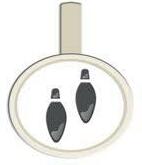
www.vegasystems-group.com 855-834-2797
KANNEGIESSER ETECH
Kannegiesser ETECH says its PowerTrans VARIO is a modern batch washer that combines flexibility, performance and low total consumptions.
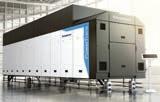
With the diversity to fit in any market segment, the VARIO is built to maximize washroom production efficiencies. The versatility of a complete standing bath washing and rinsing system allows for color changes without the need for empty pockets, according to the company.
With the large drum volume and straight wall design, the PowerTrans tunnel creates the perfect hygienically clean wash environment while keeping each batch separate.
In addition to performance, the reduction in resources provides advantages and savings in overall utility consumption, says Kannegiesser ETECH. It is built to reduce waste with intelligent water management, maximized loading volumes and efficient rinsing times. Customers are also able to produce the highest possible output within the available space due to the efficiently designed footprint of the systems.
www.kannegiesser-etech.com 612-722-1366
Mattocks hired as VP sales for Hermes
16 JULY 2020 | AMERICAN LAUNDRY NEWS www.AmericanLaundryNews.com
Continued
14
from Page
ALN
Knox
Mattocks
Marchand
Dabney
Husain
Kannegiesser ETECH
Keys to properly sizing laundry equipment

Four steps to procure the right machinery for an operation’s goods, hours, labor, space and costs
BY SETH WILLER
OSHKOSH, Wis. — All industrial, commercial and on-premises laundries process different items, utilize different pieces of equipment, strive toward unique quality goals and operate at varying levels of efficiency.
When it comes to purchasing new equipment or replacing old equipment, proper sizing is critical. Before you do anything, reach out to your equipment distributor and begin a dialogue.
The best way to properly size a laundry, and its equipment, is through back-and-forth conversations on the type and number of items being laundered, the laundry’s hours of operation, labor required, space available and ownership costs.

By considering all the variables, you’ll select the best equipment to suit your needs, now and into the future.
STEP 1: COUNT EACH PIECE OF LINEN

Laundries have their own
unique inventory of items with specific weights, profiles and dimensions. Determine the laundry’s piece count in each category, such as king sheets, duvets, towels, etc. Then multiply the number of pieces by weight for total laundry volume.
STEP 2: DETERMINE HOURLY WASH CAPACITY
Divide total laundry volume by hours per week of operation.
Girbau Industrial distributors are able to calculate hourly wash capacity, time on task, utility and labor costs. This information flows into recommendations for washing/drying, ironing and folding equipment, as well as production workflow.
STEP 3: EVALUATE COST OF EQUIPMENT OWNERSHIP
You’ve narrowed down your needs and know your equip -
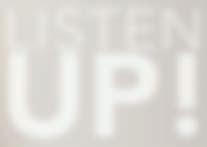








ment options. Now evaluate the cost to own those pieces of equipment in terms of labor and efficiency.
Keep in mind the most expensive part of laundry room is its labor. So while you’re planning, see how you might minimize labor in the laundry. You can do this in a number of ways, including:
1. Over equip the laundry’s wash capacity to produce more in less time.
2. Increase the laundry’s linen par. If you have a linen inventory buffer, you can run fewer hours per week and it costs you less over time.
3. Add automation. If you have the laundry volume to justify it, go with automation every time

STEP 4: JUSTIFY THE AUTOMATION
Any time you purchase new equipment, you need to justify it. The same holds true for automation. Consider these
guidelines:
All-in-One Flatwork Finisher— When a laundry processes between 180 and 260 washing pounds per hour, it might be time for an all-in-one flatwork finisher that automatically irons, folds and stacks.
An all-in-one eliminates almost all hands-on flatwork folding and stacking. An all-inone machine has the capability to process (iron, fold and stack) up to 180-plus sheets per hour with a single operator.
Towel Folder— Laundries processing 250-500-plus laundry pounds per hour should consider adding a towel folder.
Generally, a typical laundry operator can sort, fold and stack different-sized towels at a rate of 120 pieces per hour. By adding an automatic towel folder, a laundry can fold and stack at least 800 differentsized pieces per hour, with just one operator.
So remember, all laundries process different items and there are a number of variables
to consider. Sizing the laundry properly is critical for the laundry to meet their production and efficiency goals now and into the future.
Reach out to your local distributor for assistance. They will provide their expertise and guide you along the way. Your distributor is your partner before, during and after the sale. ALN
Seth Willer specializes in on-premises, commercial and industrial laundry design, equipment, workflow and productivity. As Girbau Industrial national sales manager, he works closely with laundry facilities to develop highly efficient and productive laundries for an array of industries, including hospitality, vacation rental and healthcare.
Bill Brooks, director of customer solutions and business development for commercial laundry equipment manufacturer Alliance Laundry Systems, talks about important KPIs in a laundry/linen service.

this episode, Keith Ware, vice president of sales for Lavatec Laundry Technology, talks about ways to ensure laundry machinery is handled properly to get the most life out of the equipment, and your linens.
Williams, human resources manager for Prudential Overall Supply, a uniform and facility services company headquartered in Irvine, California, joins us to talk about








www.AmericanLaundryNews.com AMERICAN LAUNDRY NEWS | JULY 2020 17
Listen in at: americanlaundrynews.com/podcasts NEW! Key Performance Indicators
Proper Laundry Equipment Usage In
and Training
Every FREE monthly episode offers: • Topics of specific interest to laundry/linen managers like you • Engaging industry-specific conversation with an expert • Business-building tips you won’t find anywhere else • Convenience of listening anytime, either online or downloading for later • Information and insight to get a leg up on competitors – give us a listen! 0720aln_House Podcast AD half_horiz.indd 1 6/10/20 9:03 AM
Laundry Hiring
Sylvia
strategies for seeking out employee candidates and training them for long-term growth.
Seth Willer
Classified Advertising








EQUIPMENT FOR SALE
PARTS FOR SALE
PARTS, PARTS, PARTS
Huge stock of parts for most laundry equipment & boilers. Also traps, valves and lubricants. Overnight delivery. Steiner-Atlantic, 800-333-8883 Fax: 305-751-8390 parts@steineratlantic.com www.steineratlantic.com

PARTS & SERVICE
In need of service and or parts for all your finishing equipment manufactured by BB&D, Lavatec, Washex, and Voss? Contact Michael @ 203-232-4004 or E-Mail me: mtenhave66@yahoo.com
®
The Griffin Group, Inc. “Recruitment Specialist” Need to FILL a position?

Call Deana Griffin 888-235-2365 www.thegriffingroup.cc deana@thegriffingroup.cc

Sales Engineer for Equipment Manufacturer


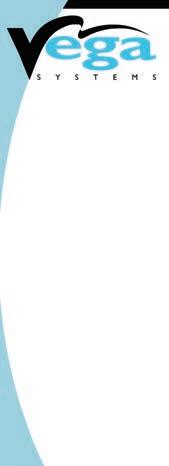


CHICAGO America’s leading manufacturer of flatwork finishing equipment is seeking a Chicago-based regional sales engineer to work with our outstanding distributor and end customer network. Excellent opportunity for long term growth in our fourth generation company. Salary and benefits commensurate with prior sales success, willingness to learn and laundry industry experience. Travel from Chicago’s manufacturing headquarters included as part of job responsibilities to serve our customer base.
Send confidential resume to: Mr. Belden belden@chidry.com
18 JULY 2020 | AMERICAN LAUNDRY NEWS www.AmericanLaundryNews.com
EQUIPMENT FOR SALE
DISTRIBUTOR OFFERINGS 2020 CLASSIFIED RATES: One- to fivetime rate: $2.80 per word, boldface $2.85 per word. Minimum charge: $25.00 per ad. Call or write for our six- and 12-time rates. If box number is used, add cost of five (5) words. Display classified rates are available on request. All major credit cards are accepted. DEADLINE: Ads must be received by the 1st of the preceding month. For example, for a June ad, the closing date is May 1st. PAYMENT FOR CLASSIFIED ADS: Must accompany order. POSITIONS AVAILABLE Available Equipment 2014 Milnor 60lb W/E TOUCHSCREEN Model:3022VRJ (5411) 2013 Jensen 3 Roll Thermal Ironer Self Contained, 3 x 32” Rolls x 120” Wide (5245) 2012 Chicago Skyline 136” single lane Model: S-13-2000 (5409) 2012 Chicago Skyline 136” 5-lane Model: SP5 W/Stacker and conveyor (5410) 2007 Chicago Edge Maxx Feeder 208V (5243) 2003 Milnor 12 Mod 130lb CBW (5362) 2006 Milnor 10 Mod 110lb CBW (5090) 2011 Milnor 4 Mod 150lb CBW (5108) 2003 Milnor 4 Mod 150lb CBW (4792) 1997 UniMac 50lb Washer (5158) 2011 Milnor 150lb Centrifugal Extractor (5109) 2003 Milnor 150lb Centrifugal Extractor (4797) 2005 Milnor 300lb 6458 Tunnel Dryer (5172) 2005 Milnor 300lb 6458 Tunnel Dryer (5175) 2005 Milnor 300lb 6458 Tunnel Dryer (5176) EXPECT EXCELLENCE Celebrating 20 Years! www.ineedjpequipment.com 800.925.3236 DESCRIPTION FOR NEW OR USED LAUNDRY EQUIPMENT, DM IS YOUR SOURCE FOR ALL YOUR NEEDS Ludell Heat & Recovery Hot Water System Kemco 2.2 Direct Contact Heater Unimac UWN – 2010 60lb Washer TD 100lb Gas Dryer Wascomat EXSM 65 Washer Electrolux Gas Ironer 19” Primary Folder Tristar 28 w/ Stacker & OPL Feeder Reconditioned Air Chicago – Reconditioned 2010 Excellent Unipress Compact Rotary Double Buck Wascomat – 135lb EXSM 6135CL B&C – 85lb Solid Mt Washer HE85 (2017) Washex FLS600 – 135lb Soft Mount Washer, New Bearing Reconditioned Milnor 250 Tunnel 72072 – 500lb System Dryers (2) Sharper 100” Steam Ironer 12” Roll Reconditioned ADC 236 Stack Dryers 30lb (10) Reconditioned Challenge Pacesetter 400lb with Model 10 Lint Collector For Pricing call Ron Hirsch 516.938.4300 • 516.315.7426 Hicksville, NY • www.directmachinery.com DISTRIBUTOR OFFERINGS NEW & USED EQUIPMENT FOR SALE ALL OPERATIONAL & AVAILABLE FOR IMMEDIATE SHIPMENT Call for Pricing: 855.834.2797 NEW Never Installed Milnor PulseFlow Model # 76039-7, 150 lb batch size, 7 modules, serial # 181461691 - Accompanying Soiled Goods Loading Conveyor - Accompanying Control Podium USED (1) 1986 Braun 400lb. Open Pocket Washer Extractor (1) 1991 Braun 800TSL Washer Extractor (2) Milnor Pony Washers (2) Challenge Chal Flo Dryers (1) Challenge Pacesetter Dryer (4) Consolidated 400lb. Gas Heated Dryers with Lint Traps (2) Milnor 76032, 110lb. 6mod CBW Washers with Milnor 2-Stage Presses (1) Milnor 76032, 110lb. 6mod CBW Washer with Senking Single Stage Press (3) Sager A Spreaders (2) American 8-Roll Hypro Ironers (2) American 6-Roll Hypro Ironer (1) American Super Sylon Ironer (3) Braun Omega Folder Crossfolders (1) Jensen FLA Constellation (1) Chicago S13 Folder Crossfolder (1) Chicago Blanket Blaster (3) Felins Tying Machines (1) Colmac CFS 900 Steam Tunnel (2) Chicago Air XL Small Piece Folder (1) Jensen Jet Small Piece Folder (1) 2003 Chicago Air Small Piece Folder (1) 1999 Chicago Air Small Piece Folder (1) Braun Sigma Small Piece Folder EQUIPMENT FOR SALE NEW FOLDERS & SELF CONTAINED IRONERS 68” - 138” Wide WWW.JBILAUNDRYFOLDER.COM AMKO AMERICA INC. Parts, Supplies, Service Remanufactured Finishing Equipment AmkoAmerica@gmail.com 561-863-9696 American LaundryNews .com More than unique visitors monthly! 5,250 www.AmericanLaundryNews.com GO TO: www.AmericanLaundryNews.com Stanco Industries, Inc. Serving The Textile Trades Since 1970 800-932-3769 k for Mike or Deb KEEPING IT GREEN SINCE 1970 Please visit our updated website: www.stancoind.com E-mail: buyer@stancoind.com EQUIPMENT FOR SALE: 225KW Cummins Diesel Generator with Fuel Tank. 120/240v. 522 Hours. 2010 Chicago Blanket Feeder And Folder S13-BB 2008 Chicago Pik Quik 2007 Chicago TriStar 32PCS Gas Ironer 2007 Chicago Skyline S-16-2000 2008 Jensen Jet Small Piece Folder 2011 Speed Queen SC80 80LB Washer 2008 Speed Queen SC60 60LB Washer 2012 Unimac UW60 Washer (Qty. 3) 2007 Unimac UC60BN2 60LB Washer 1998 Milnor 42026Q6J 135LB Washer 2006 Milnor 30022T5E 60LB Washer (Qty. 6) 2007 Milnor 40LB Washer MWR18X4 2007 Milnor 30015T5E 35LB Washer 2012 ADC 758 Gas Dryer 2015 Unimac 75LB Dryer View photos of entire inventory at www.washburnmachinery.com 800-245-8425 Keepin’ it clean for over 65 years!



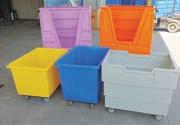



































www.AmericanLaundryNews.com AMERICAN LAUNDRY NEWS | JULY 2020 19 Source Directory A convenient guide to sources of products and services APPAREL FINISHING CARTS, TRUCKS & BASKETS Source Directory listings in American Laundry News are sold on an annual basis at the following rates: All Major Credit Cards Accepted 2020 Listings Regular Boldface All Caps Four Line Listing per Year $935 $1,170 $1,170 Display and additional line rates available upon request CARTS, TRUCKS & BASKETS CARTS, TRUCKS & BASKETS Quality For more information: G.S. Manufacturing 1-800-363-CART (2278) www.gsm-cart.com ...for the Long Haul. Precision built, all welded, anodized aluminum carts, specifically engineered for the extremes of loading, handling, cartwash and off-site transport in your busy laundry. Available in a wide range of models and sizes, and always to your custom requirements. Diversified Plastics, Inc. South Carolina & Georgia • 800.768.7636 sales@dpiroto.com • dpiroto.com BEST LAUNDRY TRUCKS & CARTS BEST LAUNDRY TRUCKS & CARTS ON-TIME DELIVERY & • Laundry Trucks • Bushel Trucks • Exchange Carts • Flare Carts • Security Carts • Spring Lifts M c C LURE INDUSTRIES, INC. 800-752-2821 • www.mcclureindustries.com email: kim@mcclureindustries.com Sani-Trux is the only molded cart to pass rigorous independent laboratory testing for NFPA fire codes Made of durable fiberglass making the cart life at least twice that of a poly cart Easy to maneuver even in tight spaces Built with quality components to last years longer than other carts Visit our website for other models and avaliable options. We sell direct to all parties! M.I.T. POLY-CART 211 CENTRAL PARK WEST, NEW YORK, NY 10024 800-234-7659, FAX: 212-721-9022 WWW.MITPOLYCART.COM l-800-275-2436 l-800-275-2436 maxi-movers.com Email:sales@maxi-movers.com INDUSTRIAL / INSTITUTIONAL LAUNDRY TRUCKS ® 6 different capacities designed to specifically handle the requirements of large industry and institutional needs. And our 10 factories nationwide reduce delivery times and cost. Ask about our Spring Lift Platforms, Vinyl Cap Covers and many other options to customize our products to your particular needs! 1 ST C L AS S C ARTS F OR 1 ST C L AS S P RO PE R TIES Lake Wales, FL 33859 Toll Free: 800.683.4116 Local: 863.638.3200 Fax: 863.638.2443 Visit DuraCast.com to explore what Dura-Cast can do for you! americanlaundrynews www. .com GO TO: www.AmericanLaundryNews.com TO PLACE YOUR AD ONLINE MISSED OUR DEADLINE?
Pellerin Milnor Corp.
P.O. Box 400, Kenner, LA 70063 504-467-9591, Fax: 504-468-3094 www.milnor.com
Pellerin Milnor Corp.
















P.O. Box 400, Kenner, LA 70063 504-467-9591, Fax: 504-468-3094 www.milnor.com
















20 JULY 2020 | AMERICAN LAUNDRY NEWS www.AmericanLaundryNews.com Source Directory A convenient guide to sources of products and services
– 100 POUNDS OR MORE
DRYERS
CLEAN CYCLE SYSTEMS 960 Crossroads Blvd., Seguin, TX, 78155 800-826-1245 • CCsystems@tqind.com www.cleancyclesystems.com DRYERS – 100 POUNDS OR LESS LINT COLLECTORS & FILTERS MAT ROLLERS contact us to book your ad TODAY! classifieds@atmags.com DRYER BOOSTER & EXHAUST FANS Gardner Machinery Corporation P.O. Box 33818, Charlotte, NC 28233 Ph.: (704)372-3890; Fax: (704)342-0758 www.gardnermachinery.com MATERIAL HANDLING / CONVEYORS www.energenics.com ENERGENICS CORPORATION TALK TO OUR DESIGN AND ENGINEERING STAFF ABOUT YOUR NEEDS 1470 Don St. • Naples, FL 34104 • 800-944-1711 ›› Our In-Line Lint Filter mounts inside, saves space! ›› OPL Duct Mounted Lint Filters 1,000 to 2,700 CFM ›› Fiberglass or Stainless Steel Dry Filters ›› Hundreds Sold Annually Source Directory listings in American Laundry News are sold on an annual basis at the following rates: All Major Credit Cards Accepted 2020 Listings Regular Boldface All Caps Four Line Listing per Year $935 $1,170 $1,170 Display and additional line rates available upon request HEALTH CARE LINEN TRANSPORT CARTS “In-House” or “Over-The-Road Transport” Ergonomic Aluminum - Tough Fiberglass – Ultimate Stainless ALL SIZES & CUSTOM C APABILITIES 800-826-1245 | www.tqind.com | TQcarts@TQind.com America’s #1 Trusted Source Since 1961! HEALTHCARE LINEN TRANSPORTS www.AmericanLaundryNews.com OPL-Series DLF-500 Lint Lasso 1,000-10,000 CFM Established: 1991 4,000-35,000 CFM Established: 1985 4” to 18” Duct Established: 2011 www.cleancyclesystems.com • 800 . 992 . 0697 ELECTRONIC REPAIRS CART-WASHING SYSTEMS What Every Laundry Needs In A Cart Washer: M c C LURE INDUSTRIES, INC email: kim@mcclureindustries.com 800-752-2821 • www.mcclureindustries.com A cart washer that works continuously for 15-20 years. The ability to install your cart washer in a cross-contamination barrier wall. A cart washer that really, truly cleans each cart of bio-contaminents inside and out. One that uses existing utilities - no remodel costs. Time selectable efficient cycles that use a minimum amount of water. www.energenics.com ENERGENICS KARTWASHERS HIGH PRESSURE FOGGING - LOW WATER CONSUMPTION 1470 Don St. • Naples, FL 34104 • 800-944-1711 Designed to wash and sanitize all popular laundry carts • 30 second dwell • Disinfection by fogging • EPA registered device • Up to 40 carts/hour Fast automatic washing, sanitizing and drying insure optimum cleaning • Low water usage • Self chemical production on demand • Exceeds healthcare certifications • No residue Concentrates wash effectiveness on the cart interior
Pellerin Milnor Corp. P.O. Box 400, Kenner, LA 70063 504-467-9591, Fax: 504-468-3094 www.milnor.com
Pellerin Milnor Corp. P.O. Box 400, Kenner, LA 70063 504-467-9591, Fax: 504-468-3094 www.milnor.com
Pellerin Milnor Corp. P.O. Box 400, Kenner, LA 70063 504-467-9591, Fax: 504-468-3094 www.milnor.com








Corp. P.O. Box 400, Kenner, LA 70063 504-467-9591, Fax: 504-468-3094 www.milnor.com

















Pellerin







www.AmericanLaundryNews.com AMERICAN LAUNDRY NEWS | JULY 2020 21 Source Directory A convenient guide to sources of products and services PARTS PARTS & SUPPLIES CINCINNATI LAUNDRY EQUIPMENT We stock all the parts you need! We have something for everybody! Parts for All Major Manufacturers 2648 Spring Grove Avenue Cincinnati, OH 45214 Phone: 513-542-5000 • Fax: 513-542-5022 www.cincinnatilaundry.com cle@cincinnatilaundry.com Your #1 AJAX Source! AJAX • CISSELL LAVATEC • ALLIANCE IPSO • HUEBSCH JENSEN HYPRO/SUPER SYLON HOFFMAN • VOSS PERMAC
– CONTINUOUS BATCH WASHER-EXTRACTOR– 100 POUNDS OR LESS WASHER-EXTRACTOR– 100 POUNDS OR MORE
WASHERS
SMALL-PIECE FOLDERS
Milnor
–
SURFACE DISINFECTION Source Directory listings in American Laundry News are sold on an annual basis at the following rates: All Major Credit Cards Accepted 2020 Listings Regular Boldface All Caps Four Line Listing per Year $935 $1,170 $1,170 Display and additional line rates available upon request Company Page Company Page INDEX OF ADVERTISERS Direct Machinery 18 GA Braun 11 Girbau Industrial 7 The Griffin Group 18 J.P. Equipment 18 Lavatec Laundry Technology 24 Monarch Brands 23 Norchem Corp. 5 Pellerin Milnor 3 R&B Wire Products 15 Stanco Industries 18 UniMac 9 Vega Systems 18 Washburn Machinery 18 ///////////////////////////////////////////////////////////////////////////////////////////// (844) 447-5559 // www.maxi-press.us PRESS MEMBRANES LAUNDRY SPARE PARTS www. americanlaundrynews .com www.energenics.com ENERGENICS DISINFECTION THE WORKHORSES OF YOUR DISINFECTION PROGRAM 1470 Don St. • Naples, FL 34104 • 800-944-1711 • “Quick Kill” Hypochlorous Generator • “UV-MAX” Ultraviolet Disinfector • “UV-Conveyor” Ultraviolet Conveyor Belts
PRESSES
EXTRACTION
Prudential Cleanroom Services opens facility in Oregon
IRVINE, Calif. — Prudential Cleanroom Services, a provider of cleanroom laundry service systems that is a division of Prudential Overall Supply, reports it has opened its Hillsboro, Oregon, Cleanroom Laundry Processing Facility.

“Our team is excited to show our customers and prospective customers our newest facility in Hillsboro, Oregon,” says CEO John Clark. “The site employs 87 full-time employees. This location provides our Northwest customers with additional products and service offerings and will help with our company’s expansion into additional markets.”
Prudential moved into its new purchased location from a nearby leased building that no longer satisfied the company’s growth requirements.
The new state-of-the-art Cleanroom Laundry Processing Plant is a 73,200-square-foot commercial laundry facility, which sits on a 4-plus-acre tract.
The project converted an existing warehouse building into a cleanroom laundry processing facility that includes offices, industrial space, employee areas, loading docks and 80-plus parking spaces on site for staff.
The company says the Hillsboro plant is its largest cleanroom laundry processing facility.
Study: Reusable PPE ensures supply, is also better for the environment
MISSION, Kan. — Hospitals scrambling to buy reusable personal protective equipment (PPE) can rest assured a permanent switch to cloth protective attire not only ensures adequate supply, but it is also better for the environment.
A study published in the AORN Journal in March compared the life cycle of reusable versus disposable surgical gowns. Reusable (cloth) surgical gowns are laundered after each use and undergo a quality inspection before being returned to the hospital for use. Hospitals pay up to 50 cents a pound to send disposable surgical gowns to the landfill.
The life cycle assessment (LCA) research was spearheaded by the American Reusable Textile Association (ARTA) and the International Association for Healthcare Textile Management (IAHTM) and was conducted by Environmental Clarity LLC.
Disposable and reusable surgical gowns were studied from their inception as raw materials in the earth to manufacture of the coverall product, to use/reuse, then to final end-of-life disposition. The scope and the results emphasize transparent, science-based life cycle analysis.
The study found that when reusable surgical gowns are used, versus disposable alternatives, the environment wins. Choosing reusable surgical gowns results in:
• 64% reduction in natural resource energy consumption.
• 66% reduction in greenhouse gas emissions (measured as CO2 eq emissions).
• 87% reduction in total water consumed (blue water).
• 83% reduction in solid waste generation at healthcare facility (results in reduced landfill costs). End users can count these improvements as a credit toward improving their sustainability programs.
Recovery of lost instruments was also included for disposable gowns, because instruments are often sent to the landfill with disposable drapes, towels and gowns.
A second end-of-life scenario considered reusable gowns reused in other industries.
Transportation was included within each of the applicable stages of the life cycle.
Crown launches city-specific informational pages on linen services for potential customers
NASHUA, N.H. — Crown Uniform and Linen, a commercial laundry service for New England, reports it has launched new city-specific pages to help customers find information on a city-by-city basis.
The reality is that New England is more than just the larger cities such as Boston or Providence, and the company says the new pages help customers in smaller cities start the learning process.
“We’re proud of our website and recognize it’s the first place many new customers go to learn about our best-in-class commercial laundry, linen and uniform services,” explains Plato Spilios, co-president at Crown. “We want people in many of the smaller cities in New England to know and recognize us as options for solving their commercial laundry solutions.”
Persons who would like to view the new pages can visit the sitemap at https://crownuniform.com/sitemap/. There, sample pages can be browsed such as the page for Waltham, Massachusetts (https://crownuniform.com/waltham/), or Nashua, New Hampshire (https://crownuniform.com/nashua/).
The Crown representative can overview the business’ needs and then correlate that with Crown linen services.
Private investment firm Architect Equity acquires Faultless Brands
LOS ANGELES — Architect Equity reports that it has acquired Faultless Brands, owners of Faultless, Niagara and Magic laundry products, Bon Ami and Kleen King cleaning products and Trapp Fragrances.
Faultless Brands is based in Kansas City, Missouri, and has been family owned for over 130 years.
“We are pleased to complete the acquisition of Faultless Brands,” says Dionisio Lucchesi, managing director of Architect Equity. “The business has a rich history of internationally recognized brands, a global distribution footprint and compelling growth plans that we are excited to support.”
Architect Equity is a private investment firm comprised of an integrated team of investors and operators that provide immediate liquidity solutions to public and private business owners. Under Architect’s ownership, target companies benefit from industry relationships, operational resources and an M&A platform to support further company growth.
Sean Williams, CEO of Faultless Brands, says, “We believe that Architect Equity is an excellent partner to help take our brands and business to the next level by supporting innovation and other growth initiatives across our portfolio.”
(TCATA) reports that it voted in this year’s Board of Directors during its April board meeting.
The association says the following members were unanimously approved onto the board:
• Michael Leeming, Parker Boiler: VP Machinery Manufacturers
• Peter Limoncelli, Yankee Equipment Systems: VP Distributors
• Gene Williams, American Laundry Products: VP Supply Manufacturers
• Bill Schitzner, Quality Fabricators: Treasurer
• Bill Odorizzi, Sankosha USA: Ex-Officio

• Bill Brooks, Alliance Laundry Systems: Machinery Manufacturers
• Orville Johnson, FabriClean Supply: Distributors
• Kelly Kelleher, Kelleher Equipment: Distributors
• Matt Lamons, Loomis Brothers Equipment Co.: Distributors
• Mack Magnus, M & B Hangers: Supply Manufacturers
• John Silverman, Tschopp Supply: Distributors
• Charles Thompson, American Trade Publications: Related Trades
The Board of Directors has been meeting regularly with Board President Fred Schwarzmann (A. L. Wilson Chemical), TCATA CEO Leslie Schaeffer and TCATA Business Manager Luci Ward via Zoom since the beginning of the year.
Continental Girbau names Aadvantage Laundry Systems as 2019 On-Premise Laundry Distributor of the Year
OSHKOSH, Wis. — Continental Girbau, one of eight brands of manufacturer Girbau North America (GNA), recently recognized Aadvantage Laundry Systems in Garland, Texas, with the On-Premise Laundry Distributor of the Year award.
Aadvantage, led by CEO Mike Zuffinetti and President Ryan Smith, a division of EVI Industries Inc., received the On-Premise Laundry award for outstanding sales and service performance within the on-premises laundry market.
Founded in 1966, Aadvantage is among the largest volume distributors in the world, says Continental. A full-service provider of parts, service and sales, Aadvantage serves the vended, multi-housing, industrial and on-premises laundry markets, providing turnkey solutions, including laundry design, financing, installation, business projections, demographic studies and highly efficient laundry equipment.
“Aadvantage delivered stellar customer service and onpremise laundry sales in 2019,” says Joel Jorgensen, GNA vice president of sales. “Aadvantage leads its territory with market-best technical service, parts and support spearheaded by a customer-centric approach of excellence. This consistently results in impressive sales.”
In memoriam: Erik de Vuyst, Lavatec Laundry Technology
BEACON FALLS, Conn. — Lavatec Laundry Technology reports that Erik de Vuyst, the company’s senior field service engineer and a valued employee since 1993, died on May 27 after a long illness. He would have turned 72 the next day.
“Erik was a truly special man,” recalls Mark Thrasher, president. “He was kind, funny and such a joy to be around.
TCATA announces
Board of Directors from April board meeting
TAMPA, Fla. — The Textile Care Allied Trades Association
“He was the hardest working man I have ever met, and he would go out of the way to help anybody. Erik’s dedication to his job and Lavatec was second to none. He will be missed by everyone here and his wife, Nyesha, whom he was married to for 17 years.”
Due to the COVID-19 crisis, the family plans to hold a memorial event in the future.
this year’s
ALN 22 JULY 2020 | AMERICAN LAUNDRY NEWS www.AmericanLaundryNews.com
Prudential Cleanroom Services recently opened its new 73,200-square-foot plant on a 4-plusacre tract of land in Hillsboro, Oregon. (Photo: Prudential Overall Supply)
Erik de Vuyst
How do

prepare customers for the new normal?


Microfiber has to be your weapon of choice to combat viruses and bacteria. As laundry professionals, most readers are well aware of the benefits of microfiber. However, are your customers educated? Have they used microfiber flat mops before? Do they understand why its important not to use the same cloth everywhere? We have developed an educational sheet to inform your customers regarding the proper use of microfiber in the workplace. Available in English and Spanish language, printed fullcolor copies can be provided with every microfiber system order.
Our goal is to inform your customers with regards to:

• What the CDC found about the superiority cleaning with microfiber
• A practical, e cient guide to room cleaning with microfiber
• Why color coding is essential to mitigate cross-contamination



• The do’s and don’ts of microfiber usage and care in the workplace
• The science behind microfiber construction that makes it so e ective
With the correct tools
and
education in place, your customers will be armed to combat COVID-19 now, and help mitigate any Fall resurgence. So, talk to us. We’ll recommend microfiber packages that work for every size and type of customer, from local restauraunts to hospital system EVS operations. Also, when minimums are met we will work with you to create your own branded material and product lines.
These bar mops are perfect for wipe-and-toss in heavily soiled environments. Weaving defects such as over-stitching or IR cuts reject perfectly good wiping tools from circulation. We buy these at a deep discount and pass the savings on to you. Packed: 100 doz/bale.

When bar mop production runs are over and inspections have been completed, mills have excess yarn. Run Of Mill (ROM) bar mops contain every bar mop that comes o the loom after the first quality run has been finalized, so are more economical than Grade A1 bar mops.
Route Ready bar mops are optically white and packed in bags of 25 so you never have to pre-wash or recount them prior to use. Typically, laundries save 70¢/doz by freeing washroom and finishing floor operators from a whole wash cycle.


(215) 482-6100 info@monarchbrands.com IRREGULAR RUN OF MILL (ROM) ROUTE READY STARTING AT $2.35 PER DOZ STARTING AT $2.95 PER DOZ STARTING AT $1.75 PER DOZ Post-Covid Microfiber Essentials FLAT MOPS SMARTRAGS HARDWARE Treated with SilvaDur by DuPont Created by Monarch Brands Visit monarchbrands.com or scan to learn more about the technology and order information. ™ ANTIMICROBIAL MICROFIBER CLOTHS SilverSure features SILVADUR ® patented silver technology that uses silver ions to eradicate the presence of undesirable bacteria and microbes from the surface of the cloth. Available in two sizes and four colors. THISCOMING SUMMER ARE YOU READY FOR THE POST-COVID CUSTOMER?
you
YOU READY FOR THE POST-COVID CUSTOMER?
ARE













































































 BY MATT POE
BY MATT POE






































































 BY ED KWASNICK
BY ED KWASNICK







 Delivering as promised. ALN
Delivering as promised. ALN

























































































































